
(Strigidae)
Typical Owls
Совові
The true owls or typical owls (family Strigidae) are one of the two generally accepted families of owls. This large family comprises 230 living or recently extinct species in 24 genera. The Strigidae owls have a cosmopolitan distribution and are found on every continent except Antarctica.
While typical owls (hereafter referred to simply as owls) vary greatly in size, with the smallest species, the elf owl, being a hundredth the size of the largest, the Eurasian eagle-owl and Blakiston’s fish owl, owls generally share an extremely similar body plan. They tend to have large heads, short tails, cryptic plumage, and round facial discs around the eyes. The family is generally arboreal (with a few exceptions like the burrowing owl) and obtain their food on the wing. The wings are large, broad, rounded, and long. As is the case with most birds of prey, in many owl species females are larger than males.
Because of their nocturnal habits, they tend not to exhibit sexual dimorphism in their plumage. Specialized feathers and wing shape suppress the noise produced by flying, both taking off, flapping and gliding. This silent flight allows owls to hunt without being heard by their prey. Owls possess three physical attributes that are thought to contribute to their silent flight capability. First, on the leading edge of the wing, there is a comb of stiff feathers. Second, the trailing edge of the wing contains a flexible fringe. Finally, owls have downy material distributed on the tops of their wings that creates a compliant but rough surface (similar to that of a soft carpet). All these factors result in significant aerodynamic noise reductions. The toes and tarsi are feathered in some species, and more so in species at higher latitudes. Numerous species of owls in the genus Glaucidium and the northern hawk-owl have eye patches on the backs of their heads, apparently to convince other birds they are being watched at all times. Numerous nocturnal species have ear-tufts, feathers on the sides of the head that are thought to have a camouflage function, breaking up the outline of a roosting bird. The feathers of the facial disc are arranged in order to increase sound delivered to the ears. Hearing in owls is highly sensitive and the ears are asymmetrical allowing the owl to localise a sound in multiple directions. Owls can pinpoint the position of prey, such as a squeaking mouse, by computing when the sound from the object reaches the owl’s ears. If the sound reaches the left ear first, the mouse must be to the left of the owl. The owl’s brain will then direct the head to directly face the mouse. In addition to hearing, owls have massive eyes relative to their body size. Contrary to popular belief, however, owls cannot see well in extreme dark and are able to see well in the day.
Behaviour
Owls are generally nocturnal and/or crepuscular and spend much of the day roosting. They are often misperceived as ‘tame’ since they allow humans to approach quite closely before taking flight, but in reality they are attempting to avoid detection through stillness. Their cryptic plumage and the inconspicuous locations they adopt are an effort to avoid predators and mobbing by small birds.
Communication
Owls, such as the eagle-owl, will use visual signaling in intraspecific communication (communication within the species), both in territorial habits and parent-offspring interactions. Some researchers believe owls can employ various visual signals in other situations involving intraspecific interaction. Experimental evidence suggests that owl feces and the remains of prey can act as visual signals. This new type of signaling behavior could potentially indicate the owls’ current reproductive state to intruders, including other territorial owls or non-breeding floaters. Feces are an ideal material for marking due to its minimal energetic costs, and can also continue to indicate territorial boundaries even when occupied in activities other than territorial defense. Preliminary evidence also suggests that owls will use feces and the feathers of their prey to signal their breeding status to members within the same species.
Migration
Some species of owl are migratory. One such species, the northern saw-whet owl, migrates south even when food and resources are ample in the north.
Habitat, climate and seasonal changes
Some owls have a higher survival rate and are more likely to reproduce in a habitat that contains a mixture of old growth forests and other vegetation types. Old growth forests provide ample dark areas for owls to hide from predators. Like many organisms, spotted owls rely on forest fires to create their habitat and provide areas for foraging. Unfortunately, climate change and intentional fire suppression have altered natural fire habits. Owls avoid badly burned areas but they benefit from the mosaics of heterogeneous habitats created by fires. This is not to say that all fires are good for owls. Owls only thrive when fires are not of high severity and not large stand-replacing (high-severity fires that burn most of the vegetation) which create large canopy gaps that are not adequate for owls.
Predators
The main predators of owls are other species of owls. An example of this occurs with the northern saw-whet owl that lives in the northern U.S. and lives low to the ground in brushy areas typically of cedar forests. These owls eat mice, and perch in trees at eye level. Their main predators are barred owls and great horned owls.
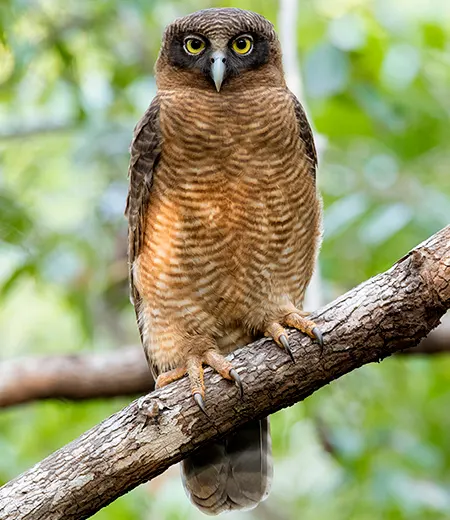
(Ninox rufa)
Rufous Owl
Сова-голконіг руда
It is native to the Aru Islands, New Guinea and northern Australia. It is mainly found in rainforests and the margins of rainforests. Additional habitats may include other forests, moist savannas, and inland wetlands.
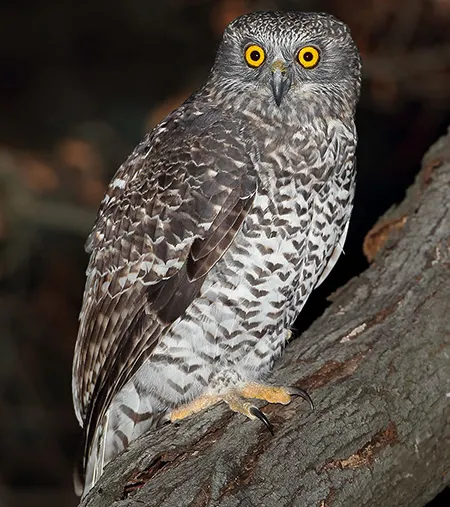
(Ninox strenua)
Powerful Owl
Сова-голконіг гігантська
It is native to south-eastern and eastern Australia. It inhabits humid tropical forests, forested valleys, coastal forests, shrub thickets, deciduous forests, pine plantations, as well as parks and gardens, at elevations up to 1,500 m.
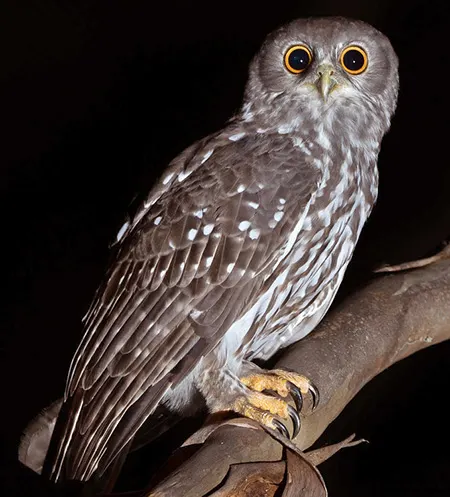
(Ninox connivens)
Barking Owl
Сова-голконіг плямиста
It is native to mainland Australia and parts of New Guinea and the Moluccas. It inhabits tropical and subtropical forests and woodlands, particularly gallery forests near rivers and swamps, at elevations up to 1,000 m.
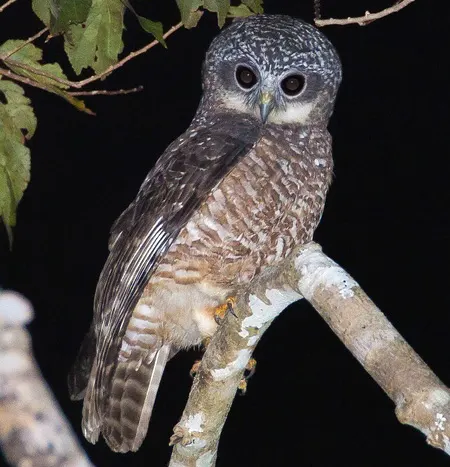
(Ninox rudolfi)
Sumba Boobook
Сова-голконіг плямистоголова
It is endemic to Sumba in the Lesser Sunda Islands of Indonesia. Its natural habitats are subtropical or tropical dry forest and subtropical or tropical moist lowland forest.
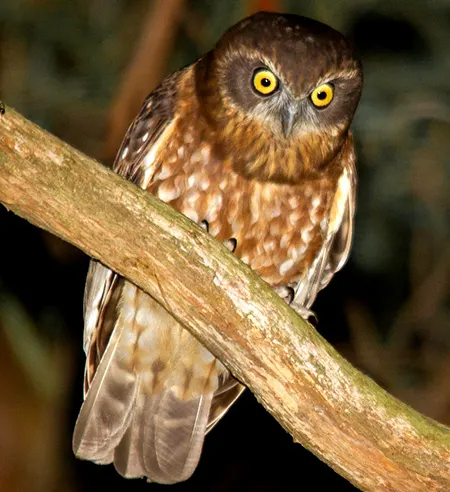
(Ninox boobook)
Australian Boobook
Сова-голконіг австралійська
It is found across mainland Australia, although it is scarce in more arid regions, and also occurs in southern New Guinea, Timor, and the Sunda Islands. It occurs in a wide range of habitats, from forest and open woodland to scrubland and semidesert areas.

(Ninox rotiensis)
Rote Boobook
Сова-голконіг роутська
It is endemic to Rote Island in the Lesser Sunda Islands of Indonesia. It inhabits dry tropical forests and mangrove forests, and is also found near human settlements.
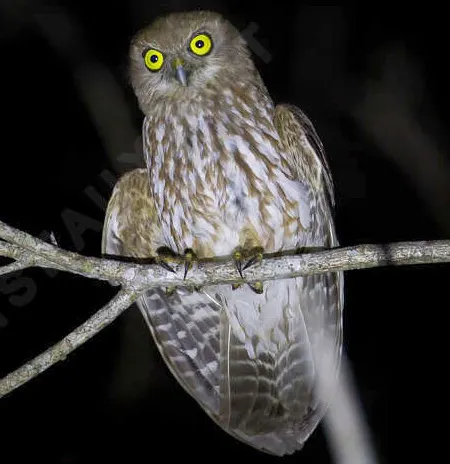
(Ninox fusca)
Timor Boobook
Сова-голконіг тиморська
It is found on Timor, Roma, Leti and Semau islands in the eastern Lesser Sunda Islands. It inhabits tropical forests.
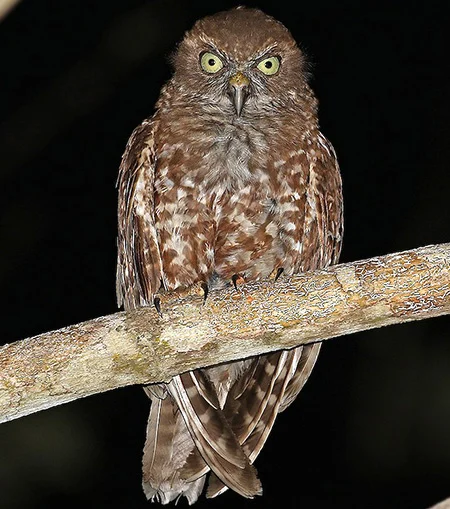
(Ninox plesseni)
Alor Boobook
Сова-голконіг алорська
It is native to Pantar and Alor Islands in the eastern Lesser Sunda Islands.
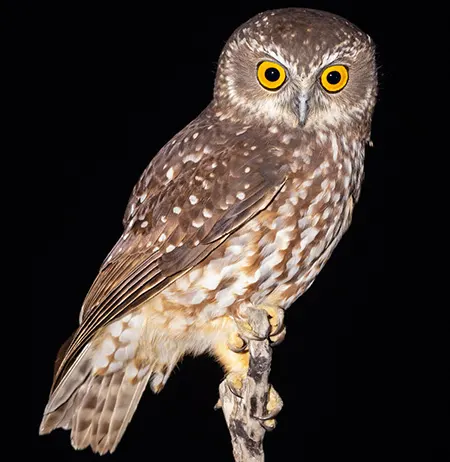
(Ninox leucopsis)
Tasmanian Boobook
Сова-голконіг тасманійська
It is widespread in Tasmania and on King Island and other islands of Bass Strait. It predominantly occurs in eucalypt forests.
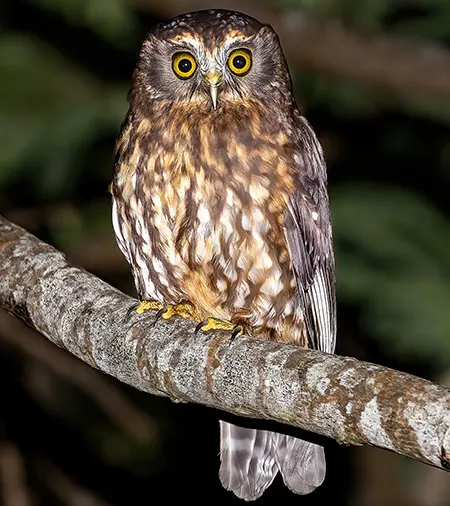
(Ninox novaeseelandiae)
Morepork
Морепорк
It is found in New Zealand, and to the northwest, on Norfolk Island, an Australian territory. It primarily inhabits forests dominated by Podocarpus, Nothofagus, Metrosideros, and other hardwoods, occurring up to the alpine tree line, as well as in pine forests.

(Ninox japonica)
Northern Boobook
Сова-голконіг японська
It is found in Siberia and much of Southeast Asia. Its habitat mainly consists of low altitude deciduous forests with thick vegetation.

(Ninox scutulata)
Brown Boobook
Сова-голконіг далекосхідна
It is a resident breeder in most of tropical south Asia from the Middle East to south China. Its habitat is well-wooded country and forest.
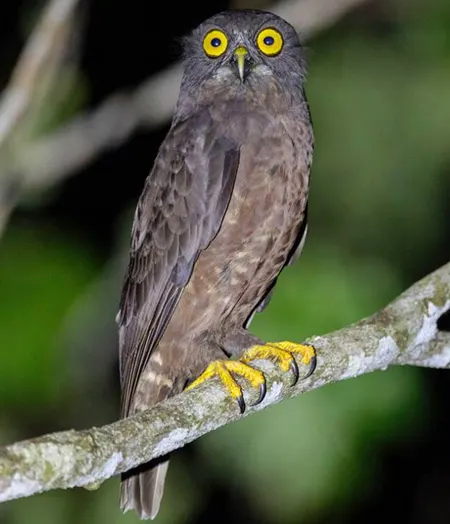
(Ninox obscura)
Hume's Boobook
Сова-голконіг темнопера
It is endemic to the Andaman Islands. Its natural habitats are subtropical or tropical moist lowland forests and subtropical or tropical mangrove forests.

(Ninox randi)
Chocolate Boobook
Сова-голконіг брунатна
It is found in the Philippines and Indonesia. It inhabits primary lowland rainforest, second-growth forest and mangroves, at elevations up to 1,000 m.

(Ninox affinis)
Andaman Boobook
Сова-голконіг андаманська
It is endemic to the Andaman Islands. Its natural habitats are subtropical or tropical moist lowland forest and subtropical or tropical mangrove forest.
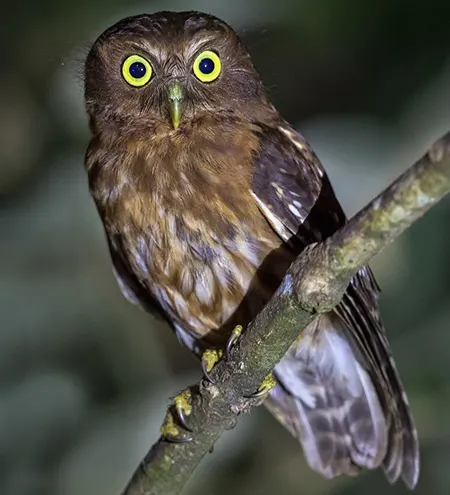
(Ninox philippensis)
Luzon Boobook
Сова-голконіг філіпінська
It is endemic to the Philippines. It can be found in forest areas up to an altitude of 1,800 m.

(Ninox spilocephala)
Mindanao Boobook
Сова-голконіг мінданайська
It is endemic to the Philippines on the island of Mindanao. Its habitat is in tropical moist lowland primary forest.

(Ninox leventisi)
Camiguin Boobook
Сова-голконіг каміґуїнська
It is endemic to the Camiguin island in the Philippines. Its habitat is in tropical moist lowland primary and secondary forests, at elevations up to 700 m.
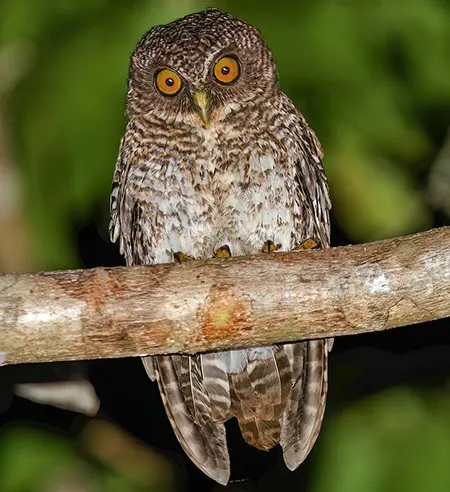
(Ninox reyi)
Sulu Boobook
Сова-голконіг сулуйська
It is endemic to the Sulu Archipelago in the Philippines. It inhabits tropical moist lowland primary and secondary forests, at elevations up to 700 m.
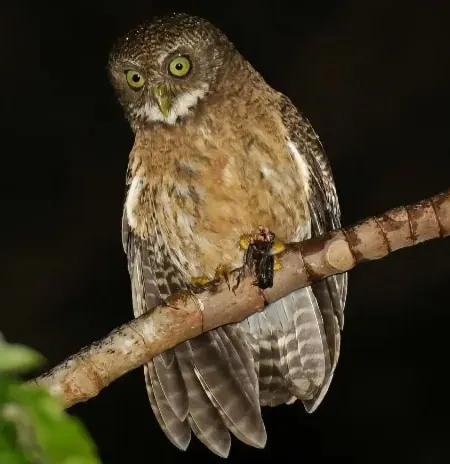
(Ninox rumseyi)
Cebu Boobook
Сова-голконіг себуйська
It is endemic to the Philippines. Its natural habitats are tropical moist lowland primary forest and secondary forests, at elevations up to 700 m.
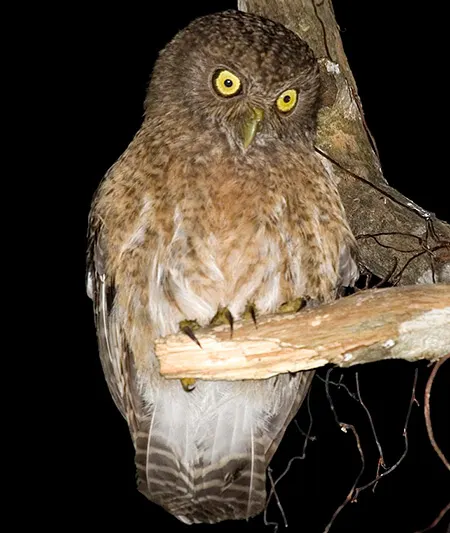
(Ninox spilonotus)
Romblon Boobook
Сова-голконіг східна
It is endemic to the Philippines. It is only found on the islands of Tablas, Sibuyan and Romblon. Its natural habitat is tropical moist lowland forest.
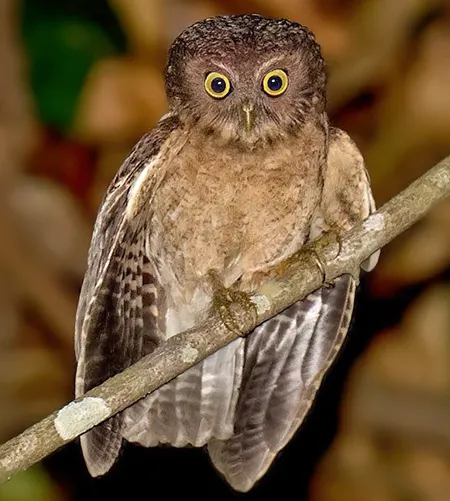
(Ninox mindorensis)
Mindoro Boobook
Сова-голконіг міндорійська
It is endemic to the Philippines. Its habitat is in tropical moist lowland primary and secondary forests, at elevations up to 1,250 m.

(Ninox sumbaensis)
Least Boobook
Сова-голконіг сумбайська
It is endemic to the Indonesian island of Sumba. Its natural habitat is subtropical or tropical moist lowland forests.
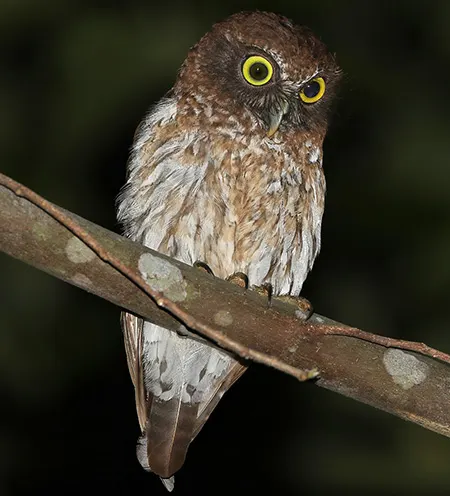
(Ninox burhani)
Togian Boobook
Сова-голконіг тогіанська
It is currently known only from three islands in the Togian group, an archipelago in the Gulf of Tomini off the coast of Sulawesi, Indonesia. It occurs in tropical rainforest, deciduous and secondary forest, gardens, and sago swamps, at elevations up to 400 m.
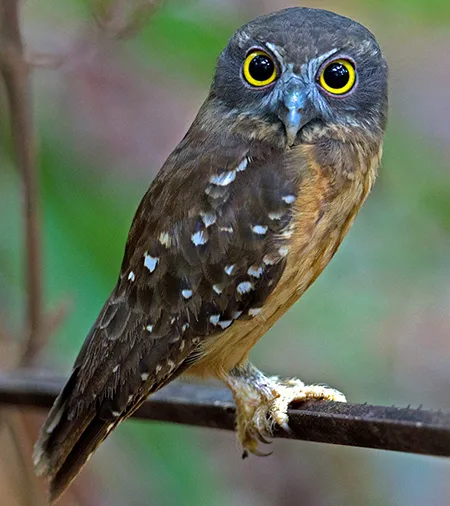
(Ninox ochracea)
Ochre-Bellied Boobook
Сова-голконіг вохристочерева
It is endemic to Sulawesi, Indonesia. Its natural habitats are subtropical or tropical dry forests and subtropical or tropical moist lowland forests.

(Ninox ios)
Cinnabar Boobook
Сова-голконіг індонезійська
It is endemic to the island of Sulawesi, Indonesia. They live in mountain tropical forests at elevations of 1,000–1,700 m.
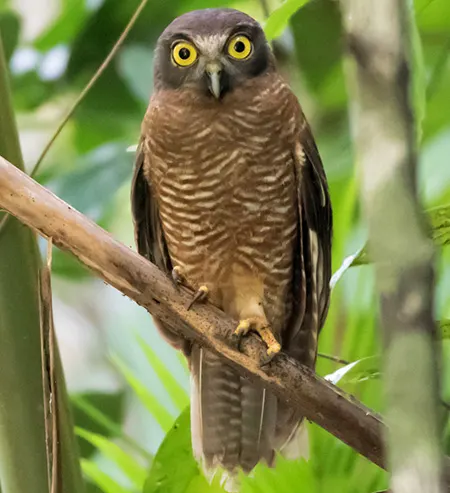
(Ninox hypogramma)
Halmahera Boobook
Сова-голконіг гальмагерська
It inhabits the Indonesian islands of Halmahera, Ternate and Bacan. Its natural habitat is subtropical or tropical moist lowland forests.
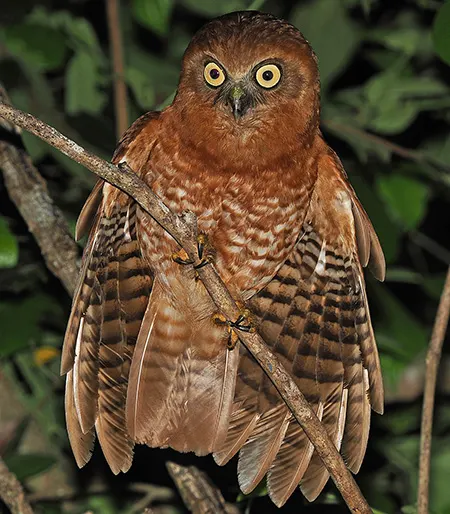
(Ninox forbesi)
Tanimbar boobook
Сова-голконіг танімбарська
It is found in the Tanimbar Islands of Indonesia. Its natural habitat is subtropical or tropical moist lowland forests, at elevations up to 1,200 m.

(Ninox squamipila)
Seram boobook
Сова-голконіг молуцька
It is found on the Indonesian islands of Seram, Kelang and Ambon. Its natural habitat is subtropical or tropical moist lowland forests.
The Moluccan boobook group also includes: Buru Boobook (Ninox hantu).

(Ninox natalis)
Christmas Boobook
Сова-голконіг острівна
It is endemic to Christmas Island, a small Australian territory of about 135² km situated in the Indian Ocean. Its natural habitats are subtropical or tropical moist lowland forest and subtropical or tropical moist shrubland.

(Ninox meeki)
Manus Boobook
Сова-голконіг мануська
It is endemic to Manus Island, in the Admiralty Islands. It lives mainly in forests, but will appear in trees near humans, and will sometimes occupy riparian habitats.
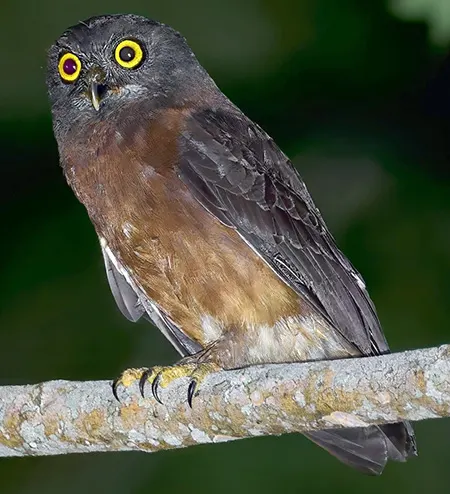
(Ninox theomacha)
Papuan Boobook
Сова-голконіг новогвінейська
It is native to New Guinea. It lives mainly in lowland forests, montane forests, and submontane forests, mainly on the forests’ edges.
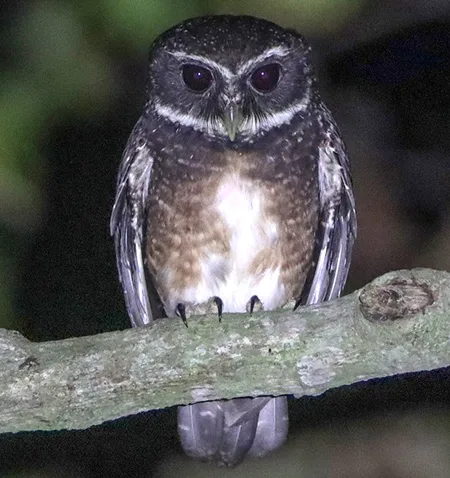
(Ninox punctulata)
Speckled Boobook
Сова-голконіг сулавеська
It is found on the island of Sulawesi in Indonesia and lives mainly in forests near streams, open woodland, and cultivated regions with scattered trees. It is mainly found at altitudes lower than 1,100 m, but is occasionally seen at up to 2,300 m.

(Ninox odiosa)
New Britain Boobook
Сова-голконіг новобританська
It is found in the lowlands and hills of New Britain and New Ireland, at elevations up to 1,200 m.
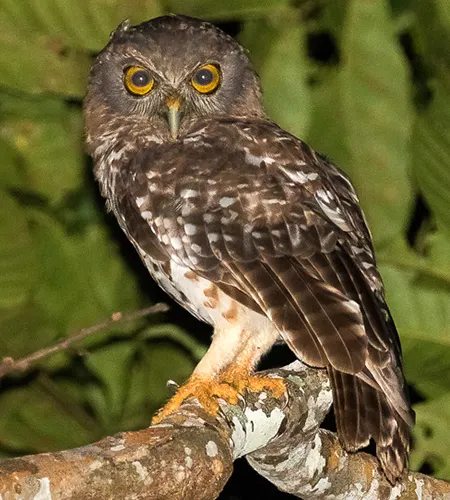
(Ninox variegata)
New Ireland Boobook
Сова-голконіг новоірландська
Endemic to the Bismarck archipelago, it occurs on the islands of New Britain, New Ireland and New Hanover, where it lives in forested lowlands, hills and mountains, up to an altitude of 1,000 m.
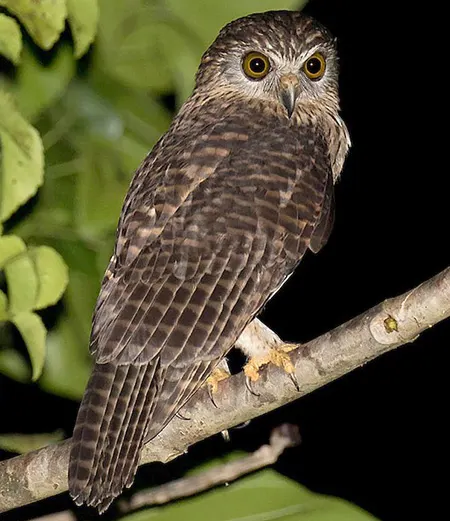
(Uroglaux dimorpha)
Papuan Hawk-Owl
Сова папуанська
It is endemic to New Guinea. It inhabits lowland rainforest or gallery forest in lowland savanna, at elevations up to 1,500 m.

(Margarobyas lawrencii)
Bare-Legged Owl
Сплюшка кубинська
It is endemic to Cuba and Isla de la Juventud. Its natural habitats include dry forests, lowland moist forests, and heavily degraded former forests, with a particular preference for palm plantations.
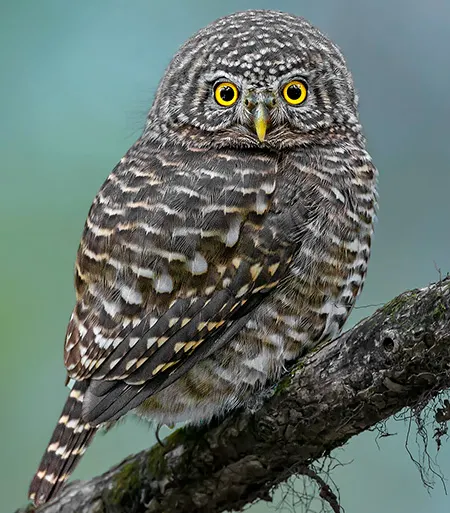
(Taenioptynx brodiei)
Collared Owlet
Сичик-горобець малий
It has a very large range occurring in the Himalayas of northern Pakistan all the way to eastern China and Taiwan. Its range extends southwards through Malaysia. Its preferred habitat varies from evergreen forests, forest edges, mixed deciduous-evergreen forests with oak, rhododendron and fir and open woodlands with scrub. It occurs at elevations of 1,350–2,750 m.
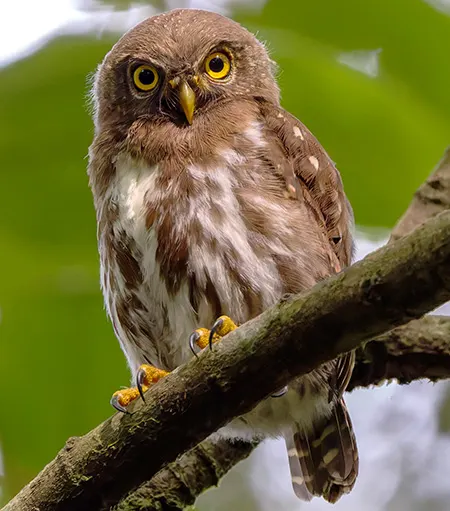
(Taenioptynx sylvaticus)
Sunda Owlet
Сичик-горобець сундайський
It is found on the islands of Borneo and Sumatra. It inhabits mountain and foothill forests at elevations of 900–2,700 m.
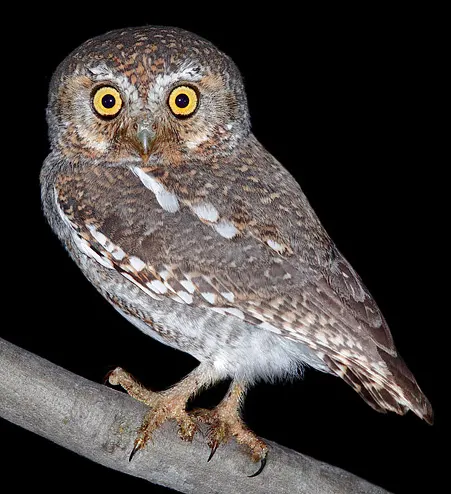
(Micrathene whitneyi)
Elf Owl
Сичик-ельф мексиканський
It is found in the Southwestern United States, central Mexico, and the Baja California peninsula. It inhabits a variety of forest types, dry grassy lowlands and wet savannas, at elevations up to 2,000 m.
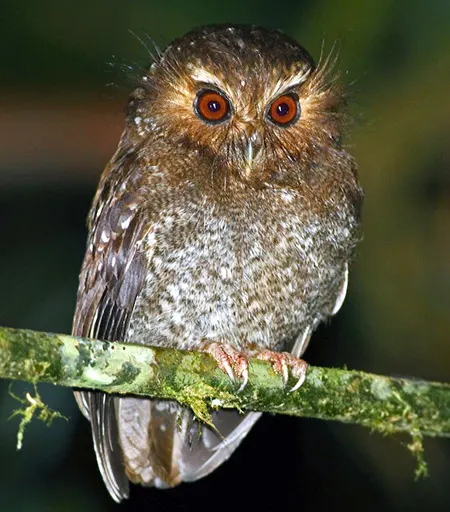
(Xenoglaux loweryi)
Long-Whiskered Owlet
Сичик-ельф перуанський
It is endemic to a small area in Amazonas and San Martín departments of northern Peru. It inhabits humid montane forest and elfin forest at elevations of 1,900–2,600 m.

(Aegolius funereus)
Boreal Owl
Сич волохатий
It is found in coniferous and mixed forests of Eurasia and North America. It breeds in dense boreal, subalpine forest as well as mixed woodland.

(Aegolius acadicus)
Northern Saw-Whet Owl
Сич північний
Its range covers most of North America south of the boreal forest, including south-eastern and south-central Alaska, southern Canada, most of the United States and the central mountains in Mexico. It inhabits coniferous forests, sometimes mixed or deciduous woods.
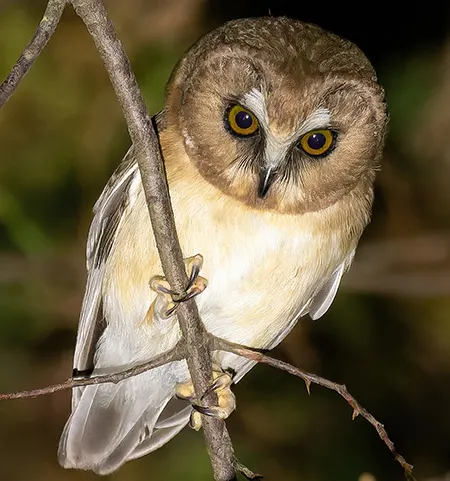
(Aegolius ridgwayi)
Unspotted Saw-Whet Owl
Сич білобровий
It is found in Costa Rica, El Salvador, Guatemala, Mexico, and Panama. It inhabits humid temperate montane forests, including humid oak forest, cloud forest, and pine–oak forest, at elevations of 1,700–3,500 m.

(Aegolius harrisii)
Buff-Fronted Owl
Сич вохристолобий
It is found in South America, from Colombia south and east to Peru, northern Argentina, and north-western Paraguay. Its range is interrupted by the Amazon Basin, where it is absent. It inhabits a variety of landscapes, including open humid forest, dry forest, forest edges, subtropical rainforest, and human-altered areas with fruit trees and palms, at elevations of 600–3,800 m.

(Athene noctua)
Little Owl
Сич хатній
It is widespread across Europe, Asia and North Africa. Its range in Eurasia extends from the Iberian Peninsula and Denmark eastwards to China and southwards to the Himalayas. In Africa it is present from Mauritania to Egypt, the Red Sea and Arabia. It breeds in the steppe and forest-steppe zones, occasionally extending into the southern parts of the forest zone.

(Athene brama)
Spotted Owlet
Сич брамінський
It breeds in tropical Asia from North Pakistan to Southeast Asia. A common resident of open habitats including farmland and human habitation, it has adapted to living in cities.

(Athene cunicularia)
Burrowing Owl
Сич американський
It is native to the open landscapes of North and South America. They are typically found in grasslands, rangelands, agricultural areas, deserts, or any other open, dry area with low vegetation.

(Athene superciliaris)
White-Browed Owl
Сич мадагаскарський
It is commonest in the drier forests and gallery forests of the south and west of Madagascar, and rather less common in the humid rainforest in the northeast. It also occurs in cultivated areas and secondary forest. It is found mainly in the lowlands, with an upper limit of 800 m.

(Athene blewitti)
Forest owlet
Сич лісовий
It has been recorded in central India, including Odisha, Chhattisgarh, Madhya Pradesh, Maharashtra, and Gujarat, where it inhabits dense forests.

(Athene jacquinoti)
West Solomons Owl
Сова-голконіг меланезійська
It is native to the western portion of Solomon Islands archipelago, where it is found in tropical or subtropical moist forests in lowlands and foothills, at elevations up to 1,500 m.
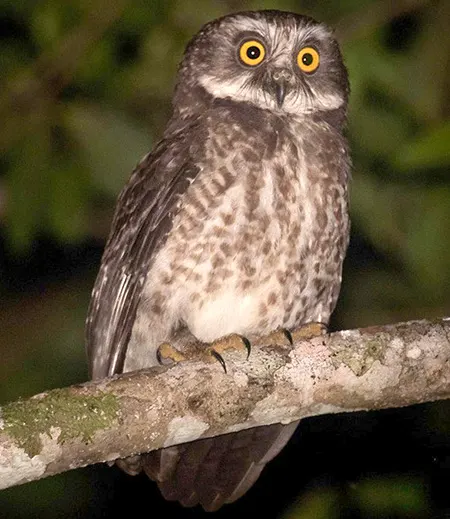
(Athene granti)
Guadalcanal Owl
Сич гвадалканальський
It is endemic to Guadalcanal Island in the Solomon Islands. It inhabits forests and forest edges at elevations up to 1,500 m.

(Athene roseoaxillaris)
Makira Owl
Сич макіранський
Mostly located on Makira Island, it is indigenous to the Solomon Islands. It lives in thick tropical rainforests, preferably in places where there is a lot of canopy cover. This species is frequently found close to water sources and has been seen in both main and secondary forests.

(Athene malaitae)
Malaita Owl
Сич малаїтанський
It is endemic to Malaita Island in the Solomon Islands.

(Surnia ulula)
Northern Hawk-Owl
Сова яструбина
It is found from eastern Alaska through Canada to Newfoundland, extending south in some areas into the northern United States, and from north-eastern Europe eastward to Siberia. It inhabits open coniferous forests, or coniferous forests mixed with deciduous species. They are found in muskegs, clearings, swamp valleys, meadows, or recently burnt areas, and generally avoid dense spruce-fir forests.
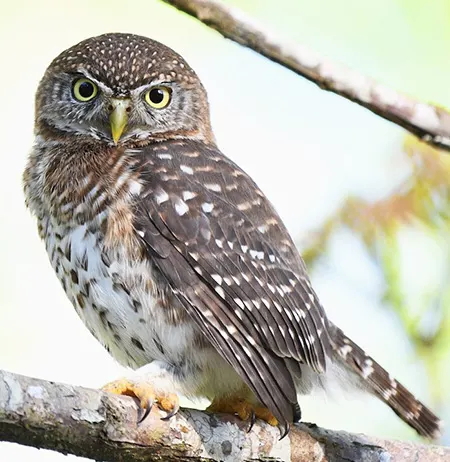
(Glaucidium siju)
Cuban Pygmy Owl
Сичик-горобець кубинський
It is endemic to Cuba. It inhabits the interiors and edges of coastal, deciduous, and montane forest, both primary and secondary. and also found in areas such as pastures with scattered trees, cultivated fields, plantations, and large city parks, at elevations up to 1,500 m.

(Glaucidium nana)
Austral Pygmy Owl
Сичик-горобець магеланський
It is found from approximately Valparaíso Province in Chile and Neuquén Province in western Argentina south to the tip of Tierra del Fuego. It inhabits a variety of landscapes from city parks and farmland with scattered trees to deciduous forests and thickets, evergreen shrublands, temperate and southern beech (Nothofagus) forests, and Patagonian steppe, at elevations up to 2,000 m.
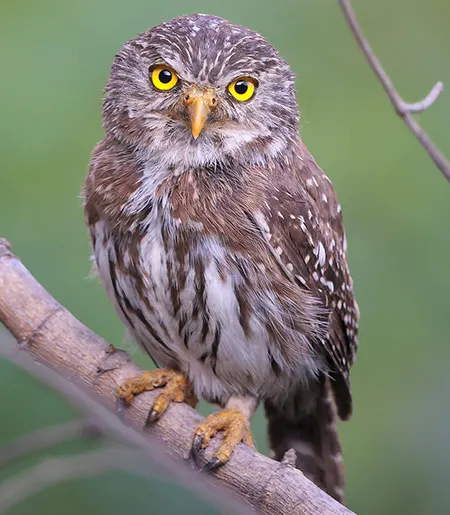
(Glaucidium peruanum)
Pacific Pygmy Owl
Сичик-горобець перуанський
It is found on the western slope of the Andes from north-central Ecuador south through Peru into Chile as far as the Antofagasta Region. It inhabits a variety of moist to arid landscapes including deciduous and riparian forest, arid lowland and montane scrublands, agricultural areas with large trees, and gardens, at elevations up to 3,500 m.

(Glaucidium brasilianum)
Ferruginous Pygmy Owl
Сичик-горобець рудий
It is found in south-central Arizona and southern Texas in the United States, extending south through Mexico and Central America into Brazil, Bolivia, Paraguay, and Argentina. It inhabits a wide range of semi-open wooded habitats at elevations up to 2,250 m.

(Glaucidium minutissimum)
Least Pygmy-Owl
Сичик-горобець крихітний
It is found in south-eastern Brazil and easternmost Paraguay. It inhabits tropical and subtropical moist evergreen forests and edges as well as open bush canopy.
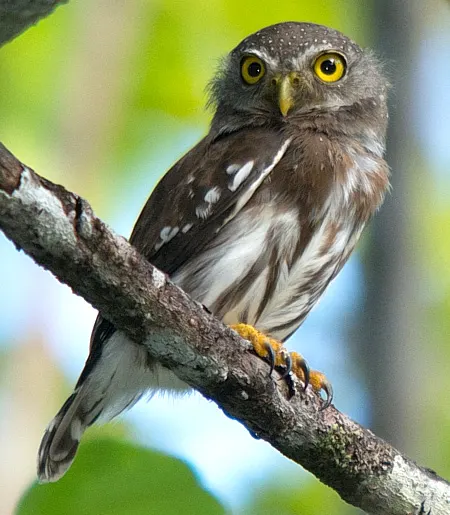
(Glaucidium hardyi)
Amazonian Pygmy Owl
Сичик-горобець бразильський
It occurs in the central and southwestern areas of the Amazonia region. Its presence has been confirmed in Brasil, northern Bolivia, in Peru, and extending east to eastern Venezuela, Guyana, Suriname, and French Guiana. It inhabits the canopy and subcanopy of tall, humid, tropical evergreen forests, at elevations up to 1,100 m.
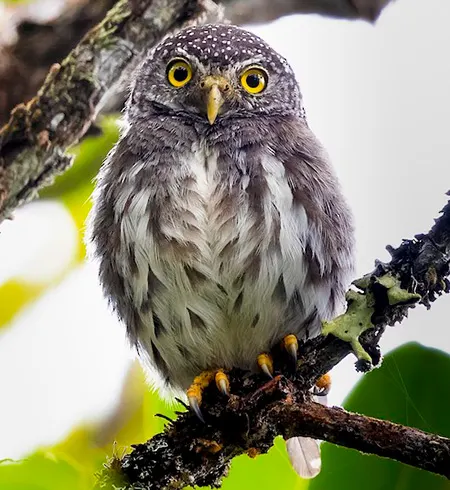
(Glaucidium parkeri)
Subtropical Pygmy Owl
Сичик-горобець бурий
It is found on the east slope of the Andes from far south-western Colombia through Ecuador and Peru to central Bolivia. It inhabits humid montane forest at elevations of 600–2,000 m.

(Glaucidium griseiceps)
Central American Pygmy Owl
Сичик-горобець буроголовий
It is found from southern Mexico through Guatemala, Belize, Honduras, Costa Rica, and Panama into northw-estern Colombia. A disjunct populations is in far north-western Ecuador. It inhabits lowland and foothill humid tropical evergreen forest, secondary forest, semi-open areas, and mature cacao plantations, at elevations up to 1,300 m.
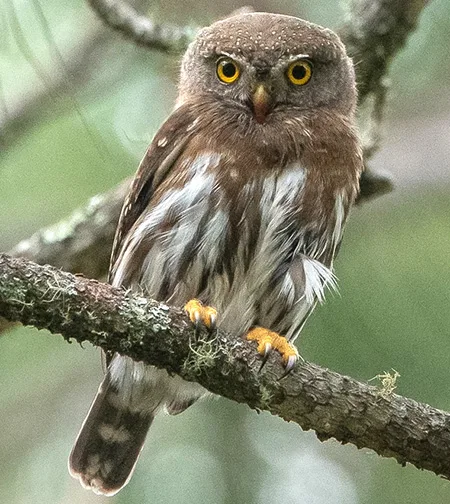
(Glaucidium sanchezi)
Tamaulipas Pygmy Owl
Сичик-горобець мексиканський
It is endemic to Mexico where it is only found in the mountains of northeastern Mexico, in the northern part of the state of Hidalgo and the southeastern part of the state of San Luis Potosí. Its habitat is moist evergreen forest, montane forest and cloud forest at elevations of 900–2,100 m.
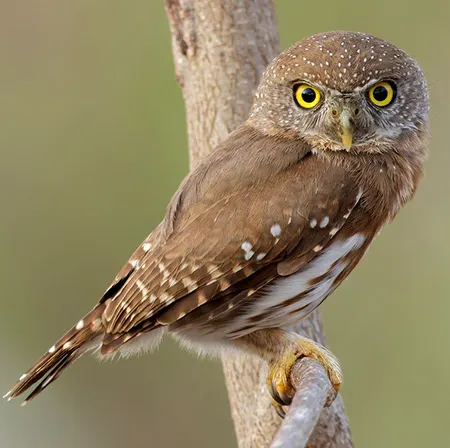
(Glaucidium palmarum)
Colima Pygmy Owl
Сичик-горобець світлоголовий
It is found in western Mexico from central Sonora south to Oaxaca, ranging from sea level up to 1,500 m in elevation. It inhabits several types of forests including thorn, tropical deciduous, lowland tropical evergreen, and the lower parts of humid montane forests. It is also found in coffee plantations.

(Glaucidium bolivianum)
Yungas Pygmy Owl
Сичик-горобець болівійський
It is found on the eastern slope of the Andes of Peru south through Bolivia into north-western Argentina. It inhabits montane forest and cloud forest with heavy undergrowth and much moss and epiphytes, and also Podocarpus forest, at elevations of 1,400–3,000 m.
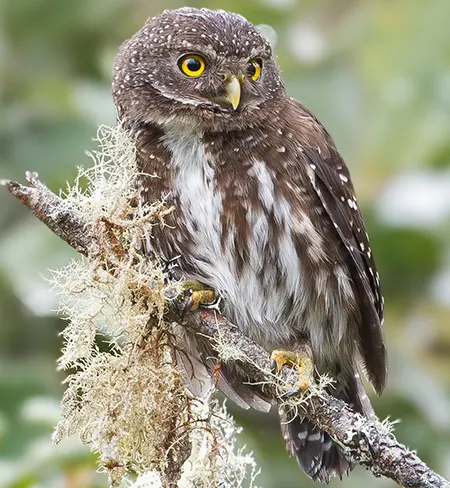
(Glaucidium jardinii)
Andean Pygmy Owl
Сичик-горобець андійський
It is found in far western Venezuela and the central and western Andes of Colombia south through Ecuador to central Peru. It inhabits a variety of mountain landscapes including cloudforest, elfin forest, Polylepis woodland, and sometimes more open landscapes, at elevations of 1,500–3,500 m.

(Glaucidium nubicola)
Cloud-forest Pygmy Owl
Сичик-горобець еквадорський
It is found throughout the Andes of western Colombia and north-western Ecuador, being confined to cloud forests between 900–2,000 m.

(Glaucidium costaricanum)
Costa Rican Pygmy Owl
Сичик-горобець коста-риканський
It is found the Cordillera Central and Cordillera de Talamanca of Costa Rica, and (patchily) into western Panama, where it inhabits the canopy and edges of humid montane oak and evergreen forests. It occurs at elevations of 900–3,000 m.

(Glaucidium gnoma)
Northern Pygmy Owl
Сичик-горобець гірський
It is native to western Canada, the western United States, Mexico, Guatemala, and Honduras. Its habitats include coniferous, broad-leaved, and mixed mountain forests, as well as tropical and subtropical oak, pine, and evergreen forests, at elevations of 1,500–3,500 m.

(Glaucidium passerinum)
Eurasian Pygmy Owl
Сичик-горобець євразійський
It is found in the boreal forests of Northern and Central Europe to eastern Siberia, Mongolia, and north-eastern China. It is found primarily in coniferous forests of the taiga and higher mountainous regions with coniferous and mixed forests.

(Glaucidium capense)
African Barred Owlet
Сичик-горобець мозамбіцький
It is endemic to Southern and Eastern Africa from Kenya and the Eastern Cape to Western Angola. It occurs in open habitats with trees such as gallery forest, woodland, forest edge and secondary growth.
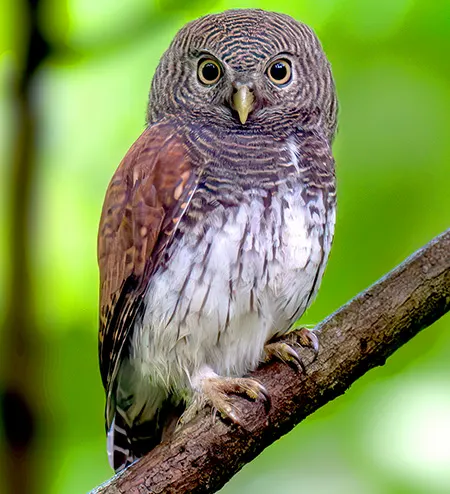
(Glaucidium castanotum)
Chestnut-Backed Owlet
Сичик-горобець цейлонський
It is endemic to Sri Lanka. It inhabits dense humid lowland and mountain tropical forests, at elevations up to 1,950 m.

(Glaucidium radiatum)
Jungle Owlet
Сичик-горобець індійський
It is found in India, Nepal, Bhutan, Bangladesh, Myanmar and Sri Lanka. It is found in habitats ranging from scrub forest to deciduous and moist deciduous forests, at elevations up to 2,000 m.

(Glaucidium cuculoides)
Asian Barred Owlet
Сичик-горобець азійський
It is found in southeast China, Bhutan, Myanmar, Laos, Vietnam, Thailand, Nepal, Bangladesh, northeast India and the foothills of the Himalayas into Pakistan. It inhabits woodland habitats such as pine and oak forests, subtropical and tropical evergreen jungles at lower elevations.

(Glaucidium sjostedti)
Sjöstedt's Barred Owlet
Сичик-горобець білогорлий
It occurs in western Central Africa, from south-eastern Nigeria east through Cameroon to the Central African Republic, and southwards to Equatorial Guinea, Gabon, northern Congo and north-western and central Democratic Republic of Congo. It is generally restricted to lowland primary forest; it avoids regions that are particularly damp, and the forest edges.

(Glaucidium tephronotum)
Red-Chested Owlet
Сичик-горобець рудобокий
It is found in Western and Central Africa. It inhabits primary rainforest and a mosaic of forest and scrub, as well as clearings and forest edges, at elevations up to 2,150 m.
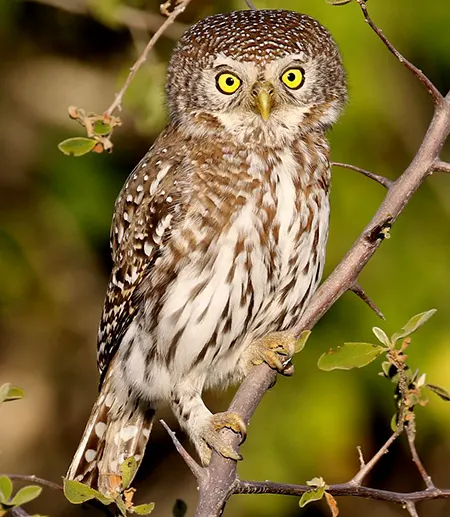
(Glaucidium perlatum)
Pearl-Spotted Owlet
Сичик-горобець савановий
It is found in sub-Saharan Africa. It occurs in a wide range of woodland and bushveld habitats, especially mopane and open thorn savanna with areas of sparse ground cover. They avoid dense woodland and forest, and open grassland and shrubland.
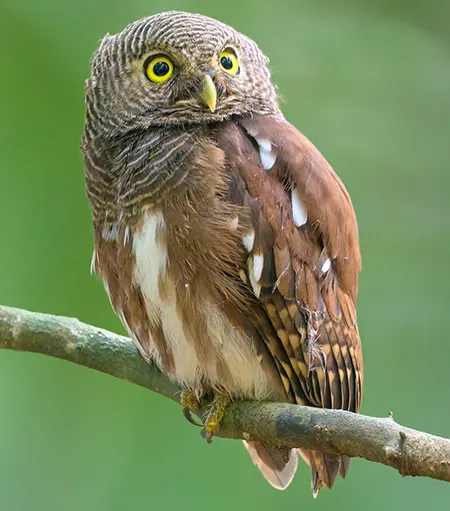
(Glaucidium castanopterum)
Javan Owlet
Сичик-горобець яванський
It is native to the islands of Java and Bali. It inhabits subtropical or tropical moist lowland forests at elevations up to 900 m.
The genus (Glaucidium) also includes: Albertine Owlet (Glaucidium albertinum), Pernambuco Pygmy Owl (Glaucidium mooreorum).

(Otus bikegila)
Principe Scops Owl
Сплюшка принсіпська
It is found only on Príncipe Island, in the Gulf of Guinea, off the coast of Africa. It is found at low elevations in old native forest, which is now confined to the southern part of the island.
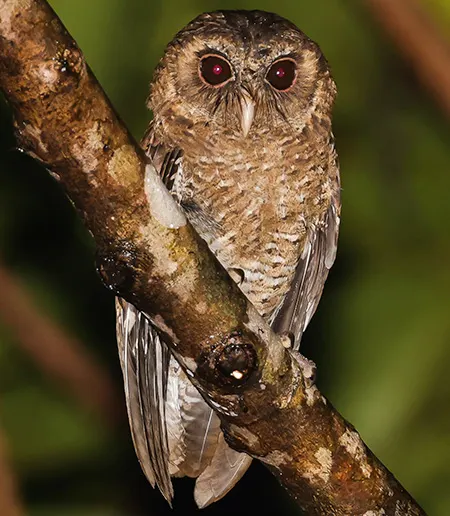
(Otus podarginus)
Palau Scops Owl
Сплюшка мікронезійська
It is endemic to the Palau Islands in the western Pacific, where they are found in woodland and lagoon trees, ravines and mangrove swamps.
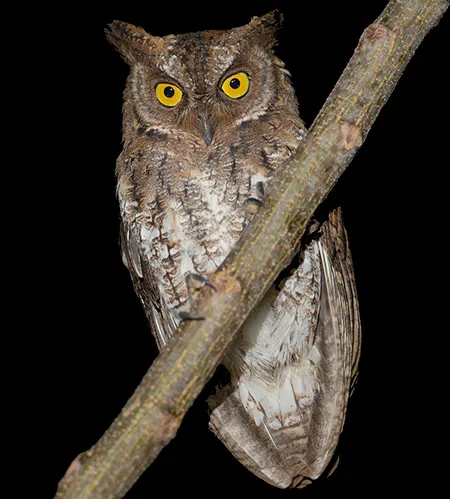
(Otus jolandae)
Rinjani Scops Owl
Сплюшка ринджанська
It is found only on Lombok in the Lesser Sunda Islands of Indonesia and its neighbouring Gili Islands. It inhabits humid tropical forests at elevations up to 1,350 m.
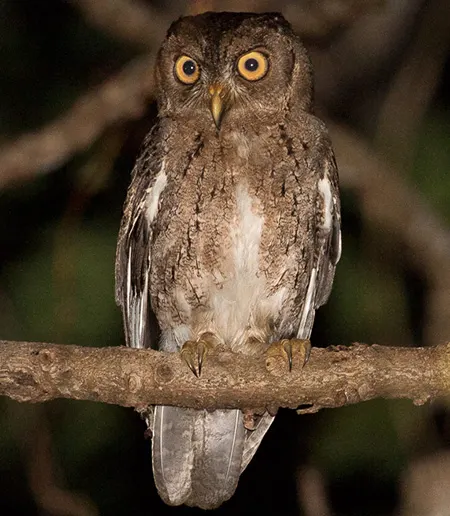
(Otus silvicola)
Wallace's Scops Owl
Сплюшка сумбейська
It is endemic to the Sumbawa and Flores islands, in the Lesser Sundas chain of Indonesia. It inhabits humid lowland and montane tropical forests, forest clearings, secondary growth, and bamboo thickets, and occurs near human settlements at elevations of 350–1,700 m.
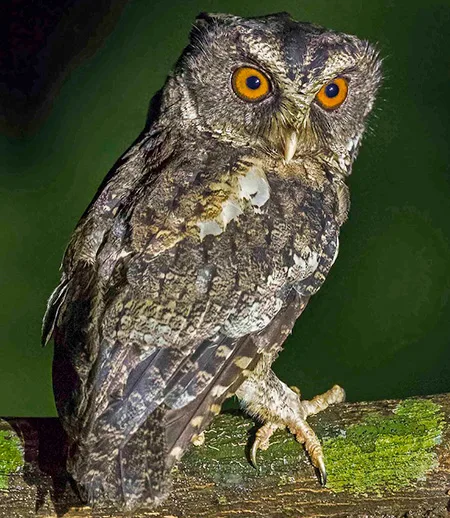
(Otus fuliginosus)
Palawan Scops Owl
Сплюшка палаванська
It is endemic to the Philippines, being found only on the island of Palawan. It is found on tropical moist lowland forest.
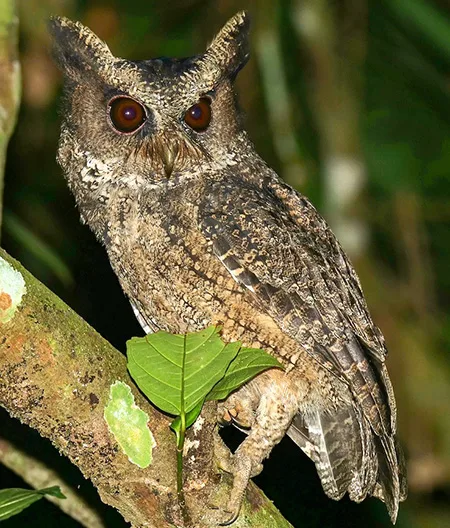
(Otus everetti)
Everett's Scops Owl
Сплюшка самарська
It is found on Bohol, Samar, Biliran, Leyte, Mindanao and Basilan. It is found in tropical moist lowland forests and the lower reaches of montane forests, at elevations up to 1,500 m.
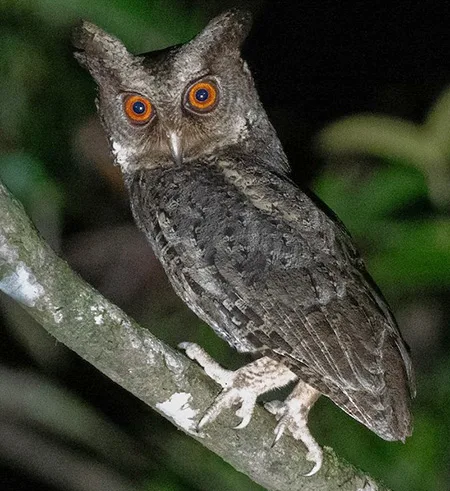
(Otus megalotis)
Philippine Scops Owl
Сплюшка філіпінська
It is found on Luzon, Marinduque, and Catanduanes in the northern Philippines. It inhabits humid lowland and montane tropical forests, at elevations of 300–1,600 m.
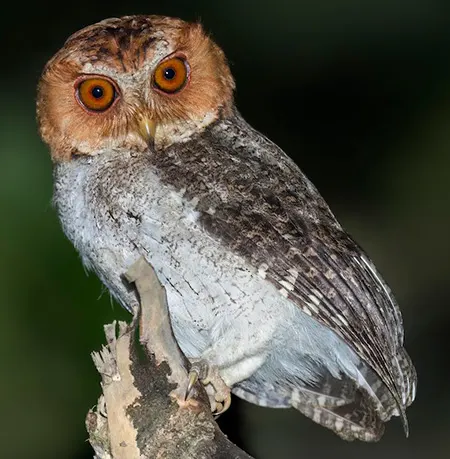
(Otus nigrorum)
Negros Scops Owl
Сплюшка негроська
It is endemic to the islands of Negros and Panay in the Philippines. Its natural habitats are tropical moist lowland and montane primary and secondary forests, at elevations up to 1,000 m.
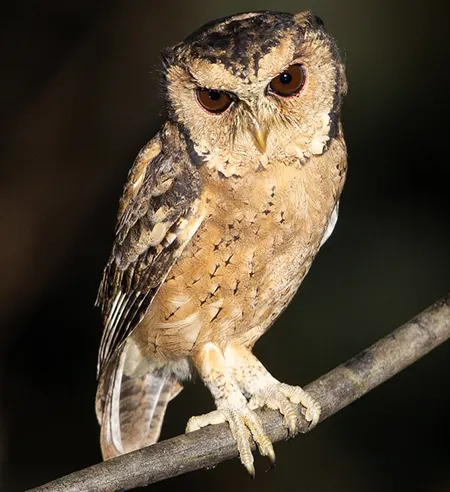
(Otus lempiji)
Sunda Scops Owl
Сплюшка калімантанська
It lives on the Malay Peninsula, Singapore, Borneo, Sumatra and Java. It can be found primarily in forests and gardens but is occasionally attracted to buildings.
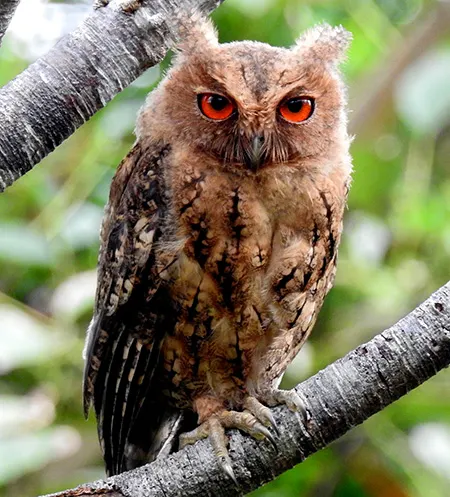
(Otus semitorques)
Japanese Scops Owl
Сплюшка японська
It is found in Japan, the Korean Peninsula, north-eastern China, and Russia (Sakhalin and Primorsky Krai). It lives in forested habitats such as lowland forests, wooded plains, and forested hillsides, at elevations up to 900 m.
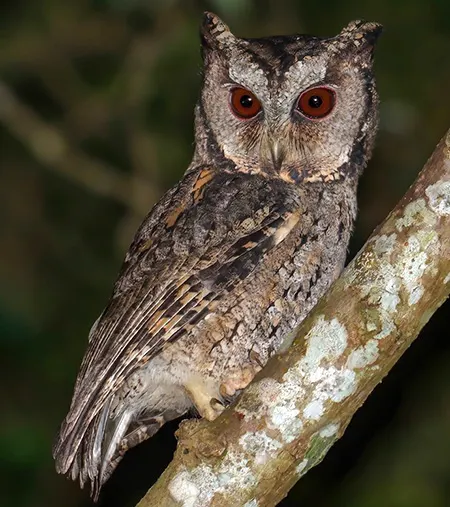
(Otus lettia)
Collared Scops Owl
Сплюшка бангладеська
It is a resident breeder in South Asia, from northern Pakistan, northern India, Nepal, Bangladesh, and the Himalayas east to southern China and Taiwan. It inhabits dry and humid tropical forests, woodlands, plantations, parks, and gardens, at elevations up to 2,400 m.
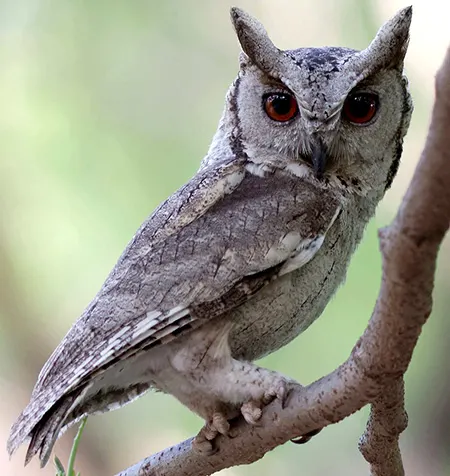
(Otus bakkamoena)
Indian Scops Owl
Сплюшка індійська
It is found in Pakistan, Iran, India, Nepal, and Sri Lanka. They live in dry and humid tropical forests, woodlands, and forested areas, in arid regions, on plantations, and in parks and gardens, at elevations up to 2,400 m.
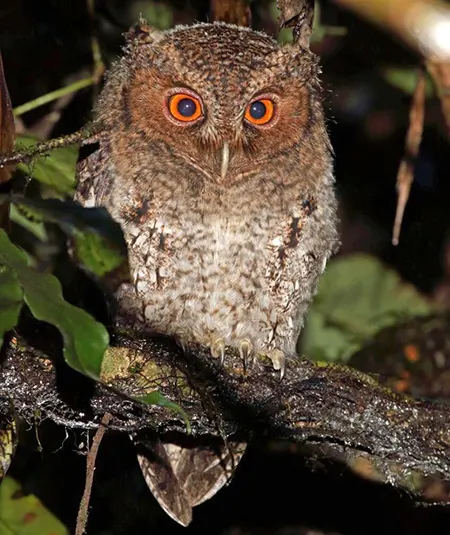
(Otus brookii)
Rajah scops owl
Сплюшка малазійська
It occurs in the Barisan Mountains of western Sumatra and in the mountains of northern Kalimantan, northern Sarawak, north-western North Kalimantan, and southern Sabah. It inhabits humid montane rainforests at elevations of 1,200–2,400 m.
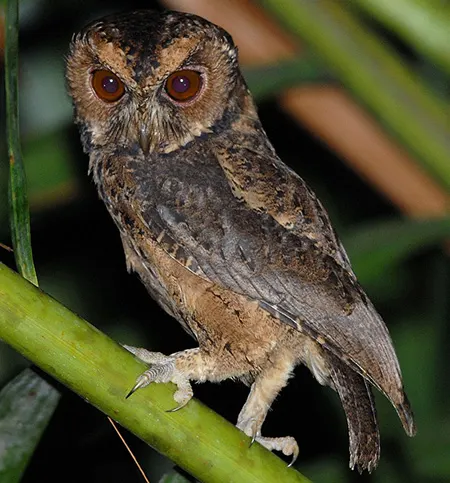
(Otus mentawi)
Mentawai Scops Owl
Сплюшка атолова
It is endemic to larger islands of Mentawai, of west Sumatra, Indonesia. It inhabits humid lowland tropical forests and secondary thickets.
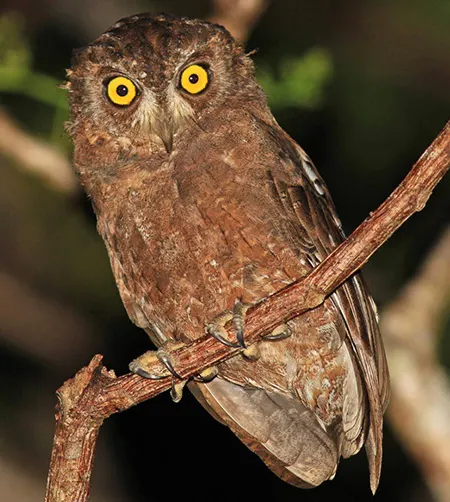
(Otus enganensis)
Enggano Scops Owl
Сплюшка енганська
It is endemic to Enggano Island, Indonesia. It inhabits humid tropical forests and woodlands.
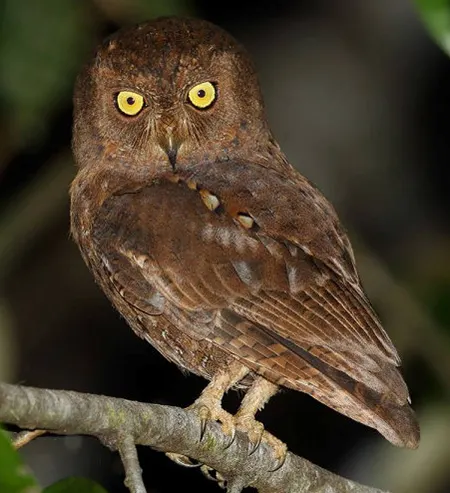
(Otus umbra)
Simeulue Scops Owl
Сплюшка сималурська
It is endemic to the island of Simeulue, Indonesia. It inhabits the edges of humid tropical forests, especially in coastal areas, and is also found in clove plantations.
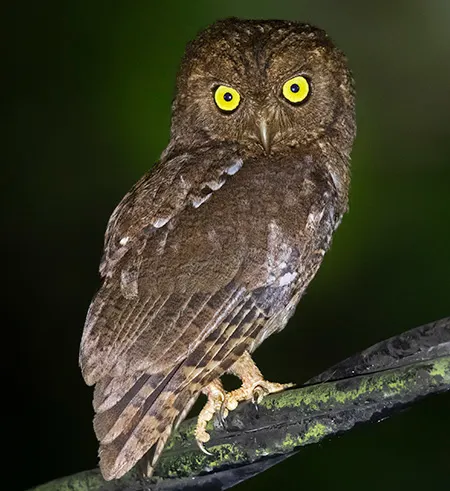
(Otus alius)
Nicobar Scops Owl
Сплюшка нікобарська
It is endemic to the Nicobar Islands, India. Its natural habitat is tropical moist lowland forests.
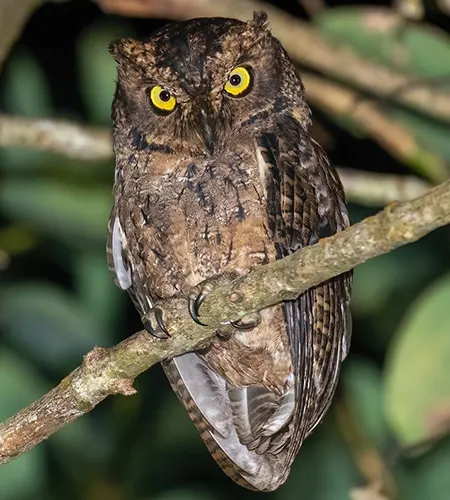
(Otus insularis)
Seychelles Scops Owl
Сплюшка магейська
It occurs in the Morne Seychellois National Park on the Seychelles island of Mahé. It lives in humid and cloud tropical forests, in gardens and plantations, at elevations of 100–700 m.
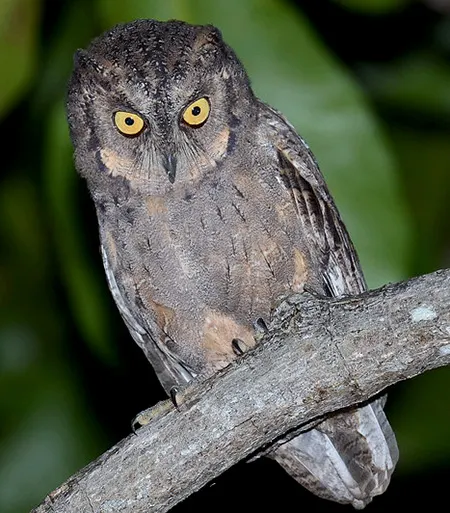
(Otus mantananensis)
Mantanani Scops Owl
Сплюшка мантананійська
It is found on small islands between Borneo and the Philippines. It lives in humid lowland tropical forests, at forest edges and clearings, and in coconut groves and casuarina plantations.
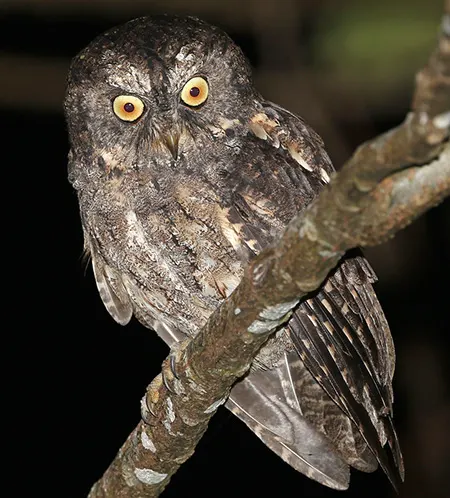
(Otus collari)
Sangihe Scops Owl
Сплюшка сангезька
It is endemic to the Sangihe Islands, occurring mainly in North Sangihe, Indonesia, where it inhabits forests and mixed plantations.
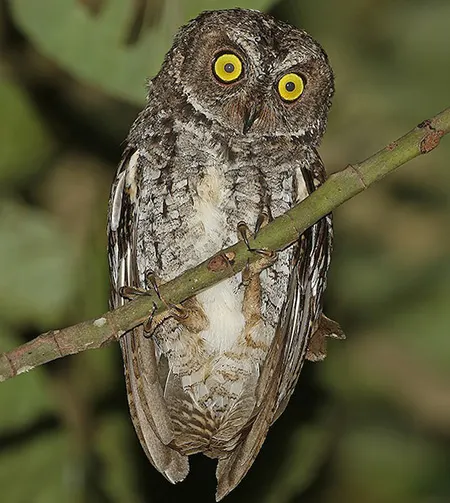
(Otus mendeni)
Banggai Scops Owl
Сплюшка бангайська
It is found on Banggai Island in Indonesia. It lives in humid flat tropical forests, at elevations up to 1,000 m.
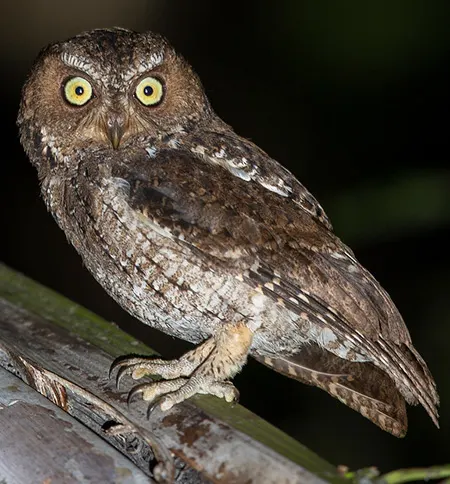
(Otus manadensis)
Sulawesi Scops Owl
Сплюшка сулавеська
It is found on the Sulawesi island of Indonesia. It lives in humid lowland and montane tropical forests, at elevations up to 2,500 m.
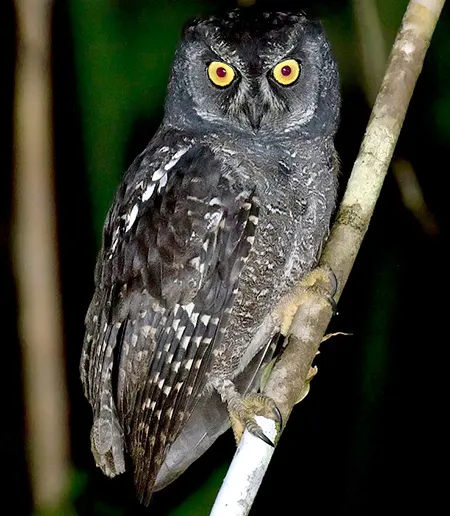
(Otus beccarii)
Biak Scops Owl
Сплюшка біяцька
It is endemic to the twin islands of Biak-Supiori in Cenderawasih Bay, Papua, Indonesia. It lives in humid lowland and swampy tropical forests, at elevations up to 300 m.
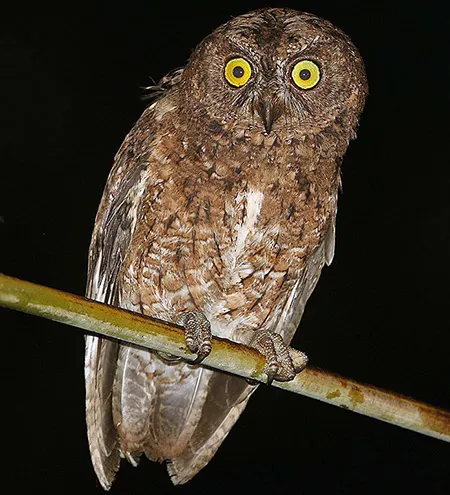
(Otus sulaensis)
Sula Scops Owl
Сплюшка сулайська
It is found on the Sula Islands of Indonesia. It lives in humid lowland and montane tropical forests and swamps, at elevations up to 1,100 m.
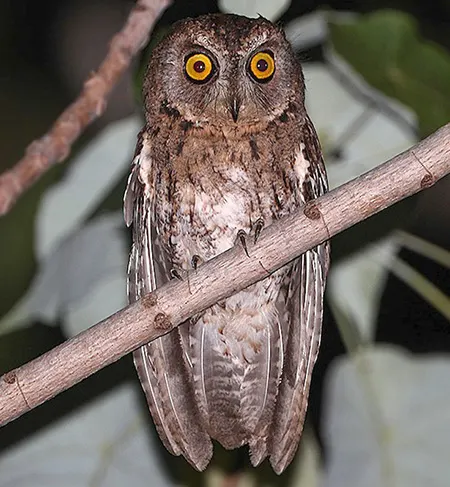
(Otus tempestatis)
Wetar Scops Owl
Сплюшка ветарська
It is endemic to Wetar of the Maluku Islands of Indonesia. It lives in humid lowland tropical forests, plantations, and gardens.
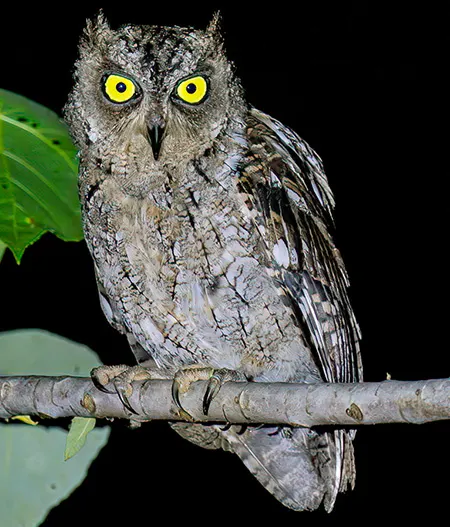
(Otus magicus)
Moluccan Scops Owl
Сплюшка серамська
It is found in the Maluku and Lesser Sunda Islands of Indonesia. It lives in lowland and swampy tropical forests, as well as on plantations and in gardens, at elevations up to 900 m.
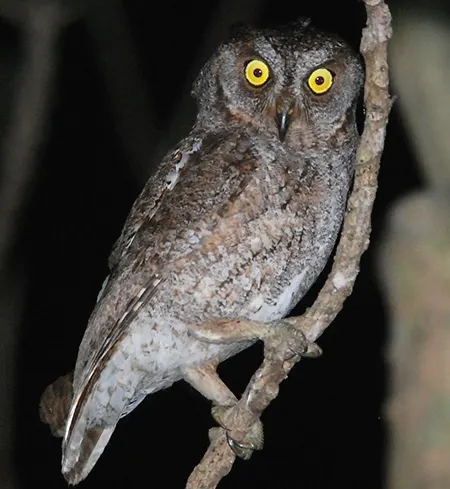
(Otus elegans)
Ryūkyū Scops Owl
Сплюшка ріукійська
It is found on the Ryukyu Islands of southern Japan, on Lanyu Island off south-east Taiwan, and on the Batanes and Babuyan Islands off northern Luzon, Philippines, in tropical or subtropical evergreen forest.
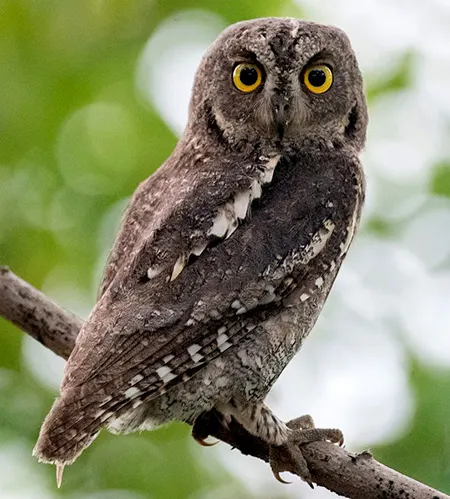
(Otus sunia)
Oriental Scops Owl
Сплюшка східноазійська
It has an extremely wide distribution across eastern and southern Asia, from the Russian Far East to Thailand. It lives in various forests and woodlands, on plantations, in parks and gardens, at elevations up to 2,300 m.
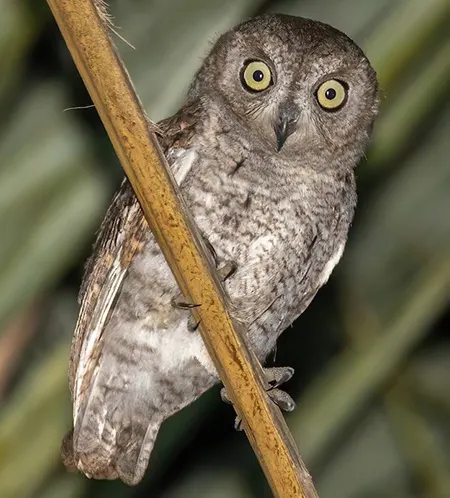
(Otus socotranus)
Socotra Scops Owl
Сплюшка сокотрійська
It is endemic to the Indian Ocean island of Socotra off the Horn of Africa. On Socotra it is found on over 45% of the island, most numerous in areas where there are mature palms. Its preferred habitat is rocky semi-desert with scattered trees and bushes.
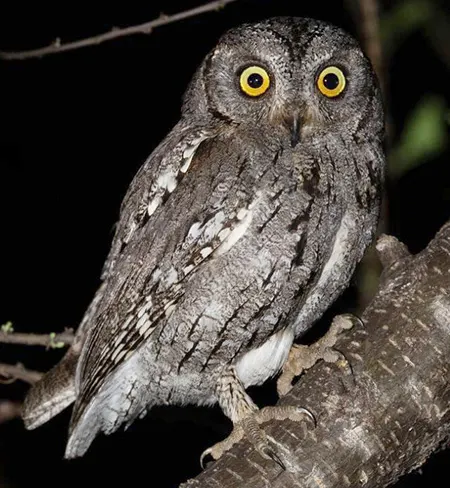
(Otus senegalensis)
African Scops Owl
Сплюшка африканська
It is endemic to sub-Saharan Africa. It ranges from sea level to 2,000 m in elevation, and is found in wooded habitats and forest edge, including in gardens and mangroves.
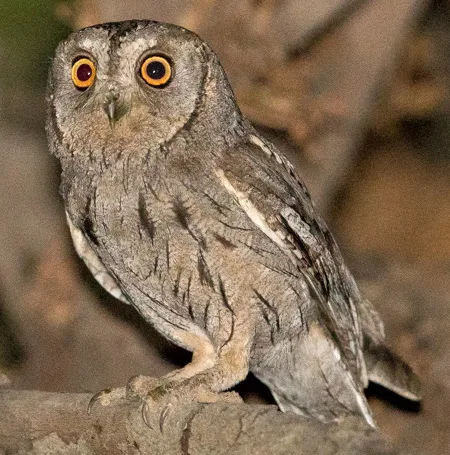
(Otus pamelae)
Arabian Scops Owl
Сплюшка бліда
It lives in the Sarawat Mountains in south-western Saudi Arabia, Yemen, and Oman. It inhabits palm groves in semi-deserts and deserts, rocky areas with little vegetation, and areas near settlements.
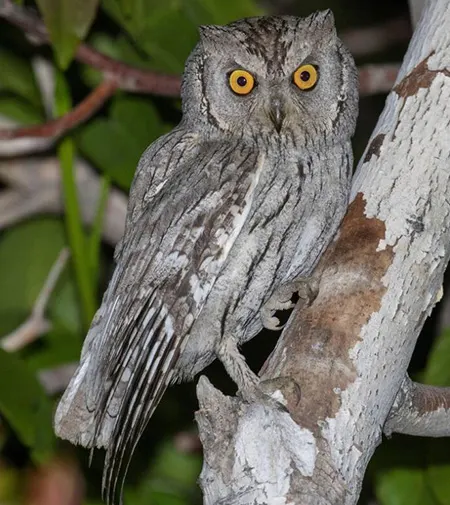
(Otus brucei)
Pallid Scops Owl
Сплюшка булана
It ranges from the Middle East to west and central Asia, with some populations migrating as far as the Arabian Peninsula, Egypt, and Pakistan in the winter. It inhabits semi-open country with trees and bushes.
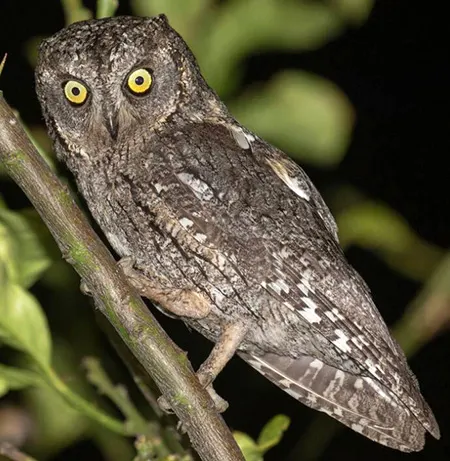
(Otus cyprius)
Cyprus Scops Owl
Сплюшка кіпрська
It is endemic to the island of Cyprus, where it occurs in rural areas, woodlands, and forests from sea level up to 1,900 m.
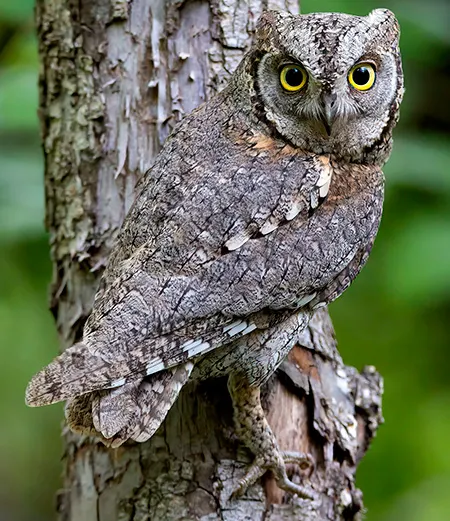
(Otus scops)
Eurasian Scops Owl
Сплюшка євразійська
It breeds in southern Europe eastwards into western and central Asia. It is migratory, wintering in southernmost Europe and sub-Saharan Africa

(Otus pembaensis)
Pemba Scops Owl
Сплюшка вогниста
It is endemic to Pemba, the northern island of the Zanzibar archipelago, off the coast of east Africa. It is found in all wooded habitats from native forest to overgrown plantations of cloves and mango. However, it is most common in native forest.
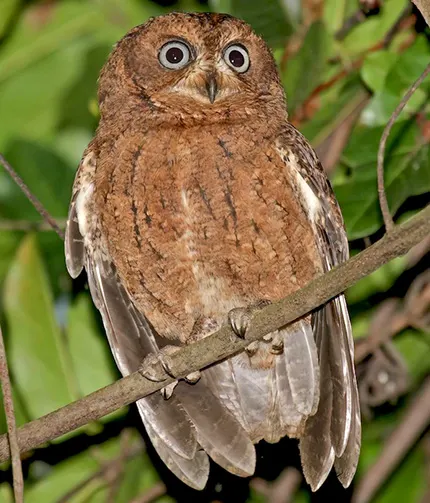
(Otus moheliensis)
Moheli Scops Owl
Сплюшка могелійська
It is found only on the mountain in the centre of the island of Mohéli, the total range covering 21 km2, including the highest point of the ridge, at 790 m in altitude, and the adjacent upper slopes. It occurs in dense humid forest, which is rich in epiphytes between 450 and 790 m.
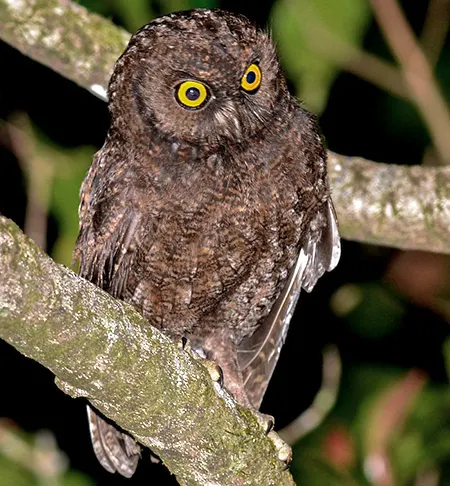
(Otus capnodes)
Anjouan Scops Owl
Сплюшка коморська
It is found only on the island of Anjouan, where it occurs in the remaining fragments of native upland forest, degraded forest and plantations.
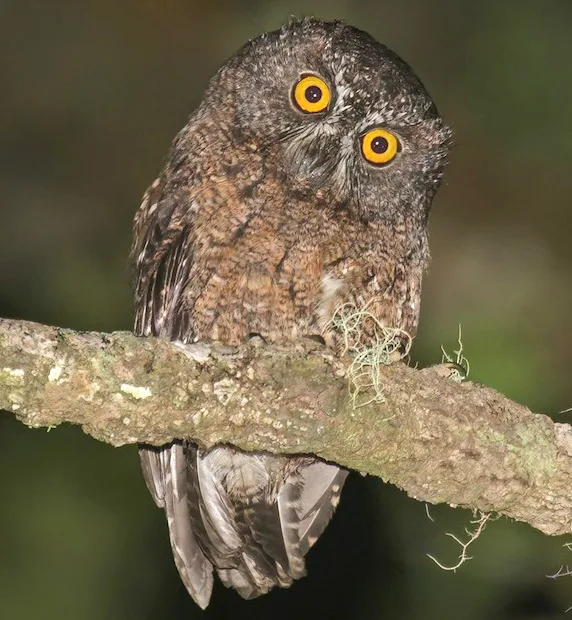
(Otus pauliani)
Karthala Scops Owl
Сплюшка карталанська
It is endemic to the island of Grande Comore, the Karthala scops owl is found only on Mount Karthala, an active volcano. Here it inhabits the montane forest, some secondary growth and the tree-heath above the forest.

(Otus mayottensis)
Mayotte Scops Owl
Сплюшка майотська
It is endemic to Maore Island in Mayotte, where it is common and widespread, inhabiting subtropical or tropical moist lowland forests.
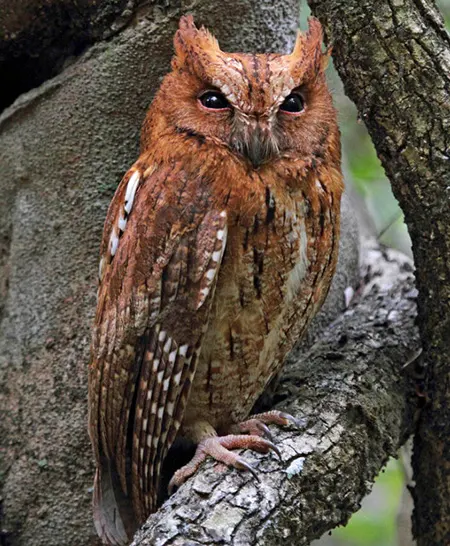
(Otus rutilus)
Rainforest Scops Owl
Сплюшка мадагаскарська
It is endemic to eastern parts of Madagascar. It prefers humid tropical forests and bush.

(Otus madagascariensis)
Torotoroka Scops Owl
Тороторока
It is endemic to western parts of Madagascar. Its natural habitat is subtropical or tropical dry forests, as well as man-made habitats such as parks, up to 2,000 m above sea level.
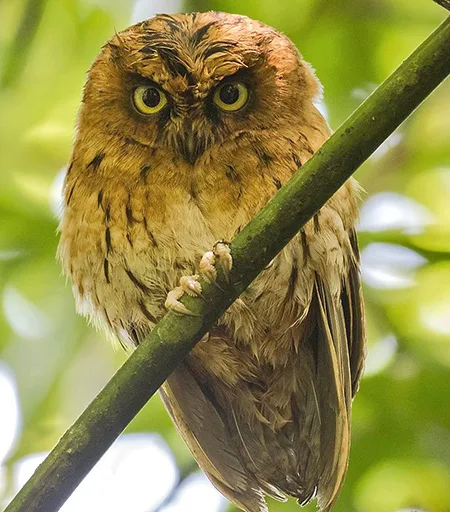
(Otus hartlaubi)
São Tomé Scops Owl
Сплюшка сан-томейська
It is endemic to São Tomé Island in the Gulf of Guinea, off the western equatorial coast of Central Africa. Its natural habitats are subtropical or tropical moist lowland forests and subtropical or tropical moist montane forests.
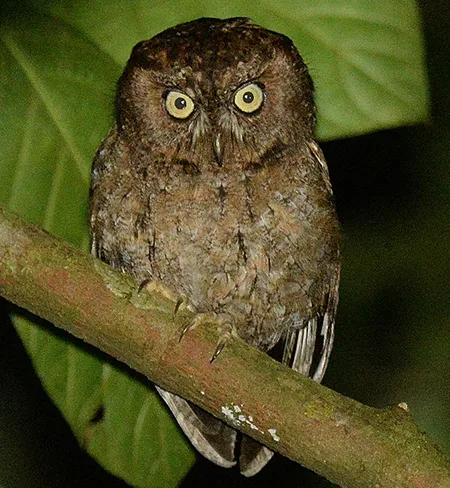
(Otus mindorensis)
Mindoro Scops Owl
Сплюшка міндорійська
It is native to the Mindoro island in the Philippines. It is found in tropical moist montane forests, at elevations above 870 m.
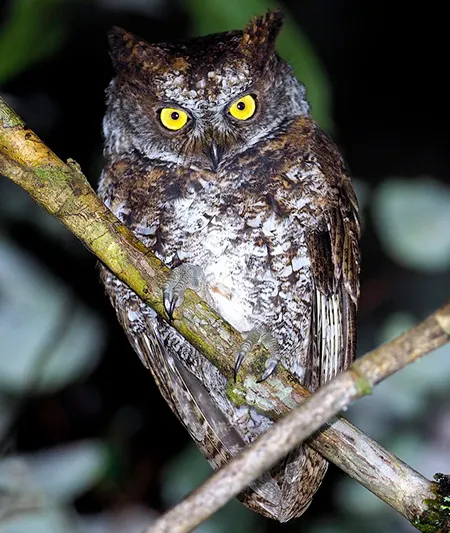
(Otus longicornis)
Luzon Scops Owl
Сплюшка лусонська
It is endemic to Luzon, Philippines. It is found in rainforests, montane forests, and tropical pine forests, at elevations of 350–1,800 m.
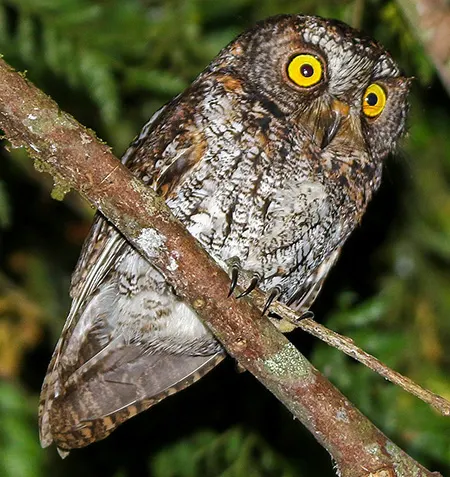
(Otus mirus)
Mindanao Scops Owl
Сплюшка мінданайська
It is endemic to Mindanao Island in the Philippines. It is found in tropical montane forest above 1,000 m.

(Otus angelinae)
Javan Scops Owl
Сплюшка яванська
It is endemic to West Java’s highland forest. It prefers montane forest with a well-developed understory at elevations of 1,500–2,000 m.
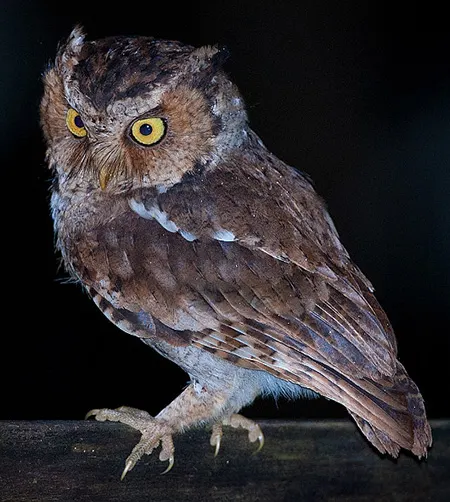
(Otus spilocephalus)
Mountain Scops Owl
Сплюшка гірська
It is found in Bangladesh Bhutan, Pakistan, India, Malaysia, Nepal, Taiwan, and Thailand. It inhabits humid montane and lowland tropical forests, at elevations up to 2,750 m.
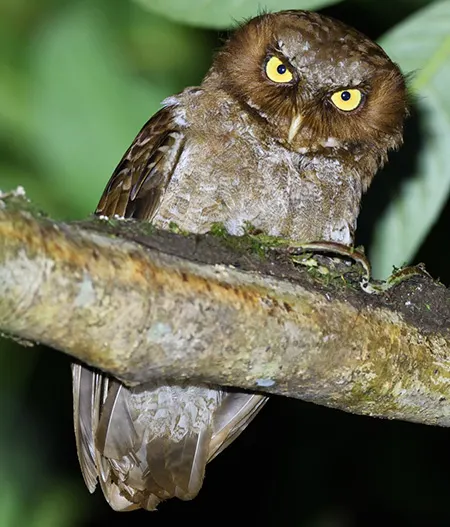
(Otus alfredi)
Flores Scops Owl
Сплюшка флореська
It is endemic to the island of Flores, Indonesia, where it inhabits montane forests at elevations of 1,000–1,400 m.
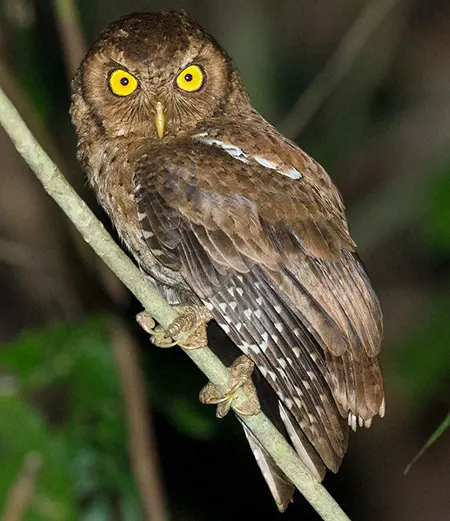
(Otus balli)
Andaman Scops Owl
Сплюшка андаманська
It is native to the Andaman Islands of India. It prefers living in trees in semi-open areas, including gardens, cultivated areas, and next to human settlements.
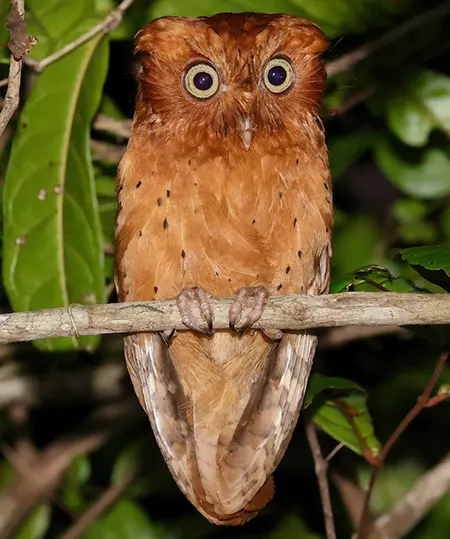
(Otus ireneae)
Sokoke Scops Owl
Сплюшка кенійська
It has a highly restricted range in coastal Kenya and north-eastern Tanzania. It has very specific habitat requirements of undisturbed lowland forest.
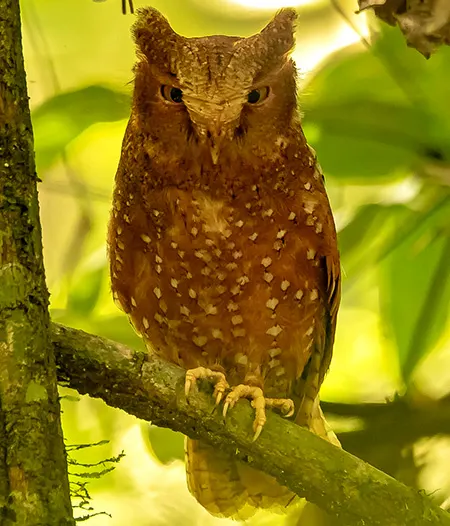
(Otus icterorhynchus)
Sandy Scops Owl
Сплюшка жовтодзьоба
It has a scattered distribution across the African tropical rainforest ; it has been recorded from Guinea, Liberia, Ivory Coast, Ghana, Cameroon, Gabon, Congo, Democratic Republic of Congo and Central African Republic. It occurs in lowland evergreen forest, open canopy forest and scrub, or in open forest mosaic land.
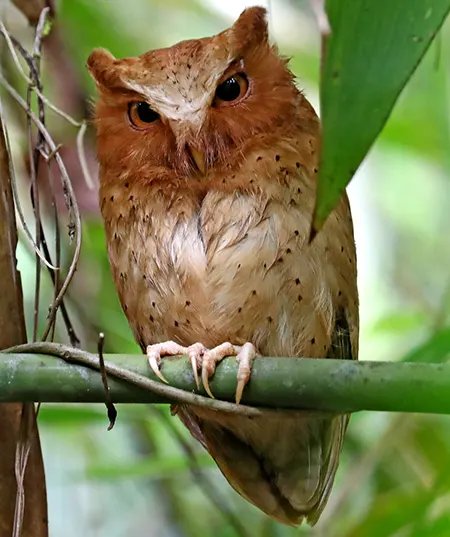
(Otus thilohoffmanni)
Serendib Scops Owl
Сплюшка цейлонська
It inhabits humid lowland tropical forests with dense undergrowth in southwestern Sri Lanka. It occurs at elevations of 50–300 m.

(Otus sagittatus)
White-Fronted Scops Owl
Сплюшка білолоба
It is found in western Thailand and in Peninsular Malaysia. Its range covers about 149,000 km² of forest, at elevations of 0–700 m.

(Otus gurneyi)
Giant Scops Owl
Сплюшка велика
It is known only from the islands of Dinagat, Siargao, and Mindanao in the southern Philippines. Its habitat is primary and secondary forests, mostly at an altitude of under 670 m although it has been seen up to 1,300 m.
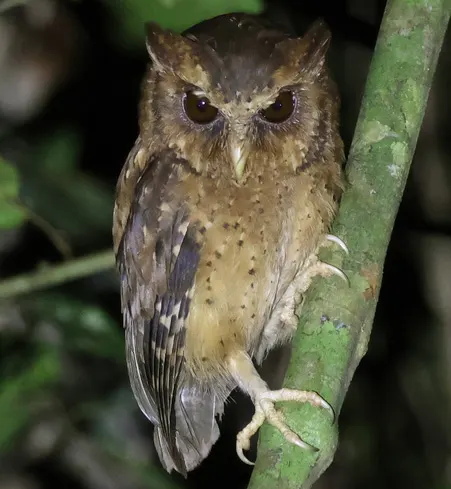
(Otus rufescens)
Reddish Scops Owl
Сплюшка суматранська
It is found in Thailand, Malaysia, Indonesia, and Brunei. It inhabits humid lowland tropical forests, at elevations up to 1,000 m.
The genus (Otus) also includes: Annobón Scops Owl (Otus feae), Siau Scops Owl (Otus siaoensis).

(Ptilopsis granti)
Southern White-Faced Owl
Сплюшка південна
It occurs patchily in the western regions central and southern Africa. It prefers open terrain with scattered trees and bushes, such as savannas and light dry forests, and avoids deserts and dense forests.

(Ptilopsis leucotis)
Northern White-Faced Owl
Сплюшка сіра
Its range extends across the African continent, from the southern edge of the Sahara and the north-eastern tip of Africa, and from Senegal and Gambia in the west to Somalia in the east. It inhabits savannahs, open woodlands, dry woodlands, forest edges and clearings, and moderately dense riverine forests.
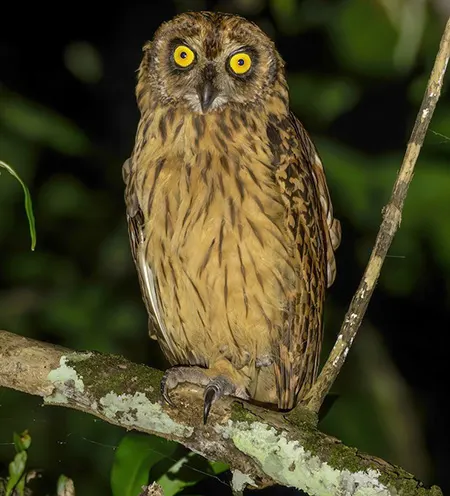
(Asio solomonensis)
Fearful Owl
Сова соломонська
It is endemic to the island of Bougainville in Papua New Guinea and to Choiseul Island and Santa Isabel Island in the Solomon Islands. It is found in old-growth lowland and hill forest, usually in primary forest but also sometimes in nearby secondary forest and woodland edges up to 2,000 m.

(Asio capensis)
Marsh Owl
Сова африканська
They are common in the grasslands of southern Africa, occurring in the northern regions of South Africa down to the province of the Eastern Cape. They are also found in Zimbabwe on the Mashonaland plateau, and in the Makgadikgadi lacustrine depression in Botswana.

(Asio flammeus)
Short-Eared Owl
Сова болотяна
It occurs on all continents except Antarctica and Australia; thus it has one of the most widespread distributions of any bird. It breeds in Europe, Asia, North and South America, the Caribbean, Hawaii and the Galápagos Islands. It is partially migratory, moving south in winter from the northern parts of its range.
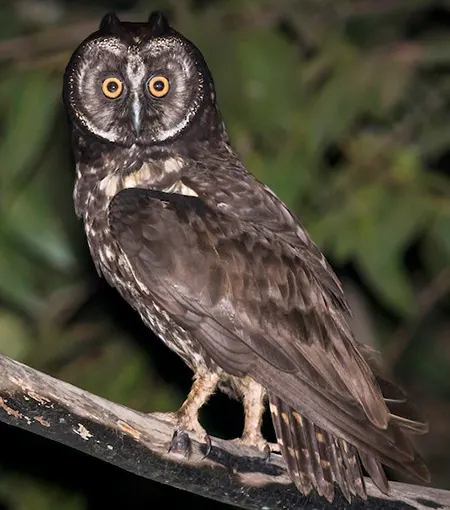
(Asio stygius)
Stygian Owl
Сова темна
It is found in Mexico, parts of Central America, Cuba, Hispaniola, and 10 countries in South America. It inhabits montane pine, pine-oak, and cloud forests, thorn scrub, cerrado, pine plantations, and even urban parks, at elevations up to 3,000 m.
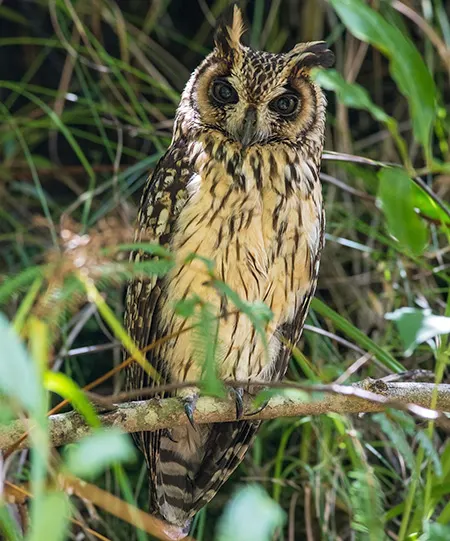
(Asio madagascariensis)
Madagascar Owl
Сова мадагаскарська
It is endemic to Madagascar, where it is widespread in the western and central regions of the island, at elevations up to 1,800 m. It inhabits a variety of woodland habitats, mainly in the drier western forests, although it appears quite adaptable, and also occurs in degraded habitats, even on the central plateau where the forest cover has been fragmented.
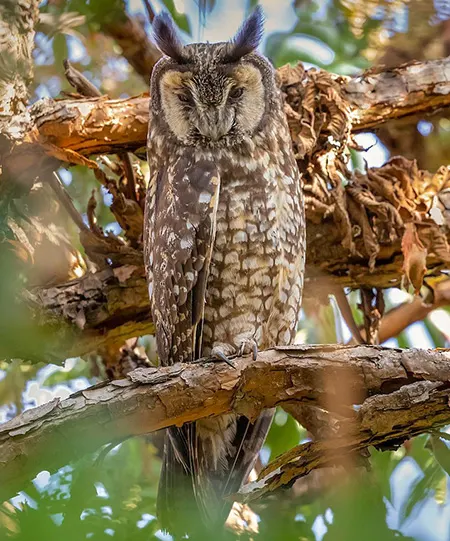
(Asio abyssinicus)
Abyssinian Owl
Сова ефіопська
It lives in the Albertine Rift montane forests, Ethiopia and northern Kenya. It prefers open grasslands or moorlands with oak or cedar forests, and it is found in mountain valleys and gorges at elevations of up to 3,900 m.
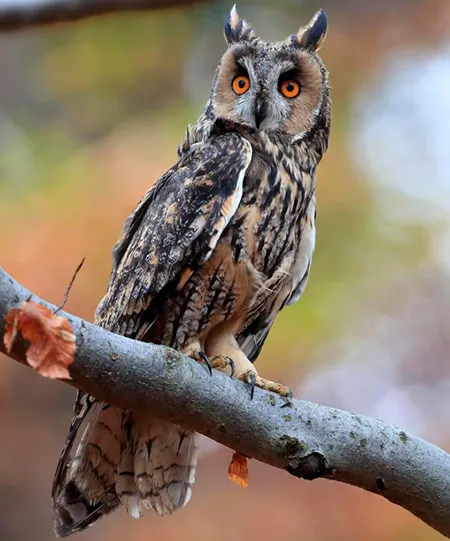
(Asio otus)
Long-Eared Owl
Сова вухата
It is widely distributed in Europe and North Asia, from north of the high-trunked forest zone to the Okhotsk coast, Primorye, and Japan (Hokkaido), and south to Iraq, Central Asia, the Himalayas, and China. It also occurs in North Africa, the Canary Islands, and North America.

(Asio clamator)
Striped Owl
Сова-крикун
It is native to much of South and Central America. It uses a variety of habitats, including riparian woodlands, marshes, savannahs, grassy open areas, and tropical rainforests, at elevations up to 1,600 m.

(Asio grammicus)
Jamaican Owl
Сова ямайська
It is found throughout the island of Jamaica. It inhabits a variety of open and semi-open landscapes such as open woodland, forest edges, plantations, and gardens. It is primarily a bird of coastal and lowland areas, but can be found as high as 600 m of elevation in the mountains.
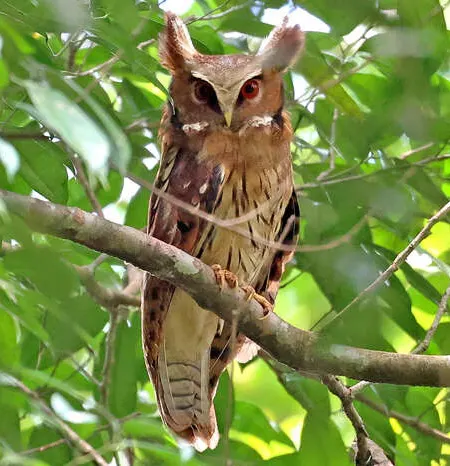
(Jubula lettii)
Maned Owl
Сова-рогань африканська
It is known only from the lowland, tropical rainforest of west Africa and has a patchy distribution from Liberia in the west through to the Democratic Republic of Congo.
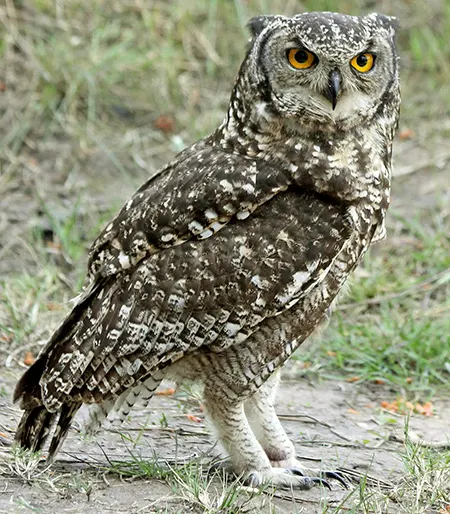
(Bubo africanus)
Spotted Eagle-Owl
Пугач африканський
It occurs throughout sub-Saharan Africa and the Arabian Peninsula. It is found in thorn savanna and suburban gardens.
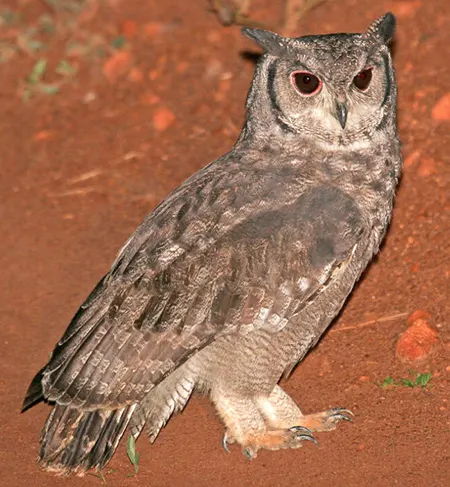
(Bubo cinerascens)
Greyish Eagle-Owl
Пугач сірий
It is found in the northern part of sub-Saharan Africa from Mauritania and Liberia east to Sudan and Somalia. Its habitats include dry rocky deserts and open savannah, as well as lowland forests in Somalia.
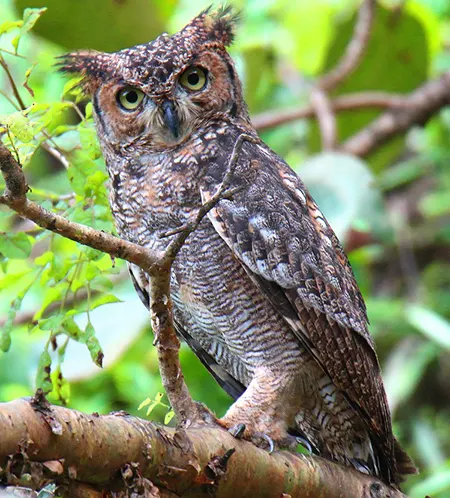
(Bubo milesi)
Arabian Eagle-Owl
Пугач аравійський
It is endemic to the Arabian Peninsula, occurring in southwestern Saudi Arabia, Yemen, Oman, and the United Arab Emirates. It is found mainly in coastal areas and slightly inland, avoiding the most barren parts of the desert interior.

(Bubo capensis)
Cape Eagle-Owl
Пугач капський
Its range is limited to the southernmost regions of southern Africa and parts of East Africa. It occurs in mountainous and hilly areas with rocks, as well as adjacent woodlands, grasslands, and wooded gullies, up to 2,500 m.
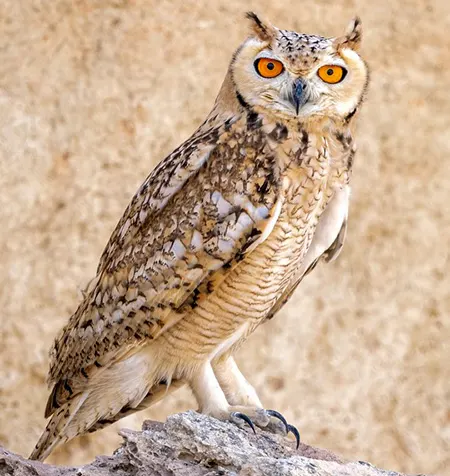
(Bubo ascalaphus)
Pharaoh Eagle-Owl
Пугач пустельний
It is native to much of arid Northern Africa, including some of the most desolate parts of the central Saharan Desert, and extending east into the Arabian Peninsula and the Middle East. Its preferred habitat is mostly open, barren plains or desert with scattered palms or other endemic plants, where it nests in rocky outcrops, wadis and cliffs.
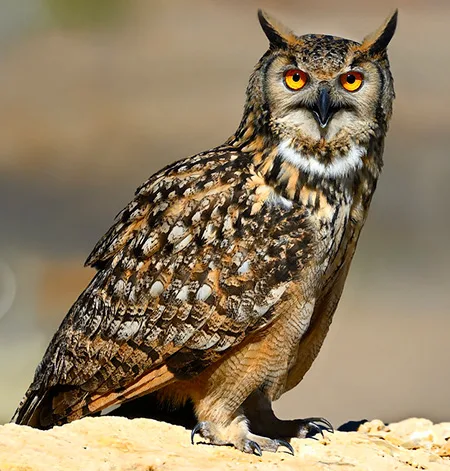
(Bubo bengalensis)
Indian Eagle-Owl
Пугач індійський
It inhabits scrub and light to medium forests, but is especially common near rocky areas within the Indian subcontinent south of the Himalayas, below 1,500 m elevation.
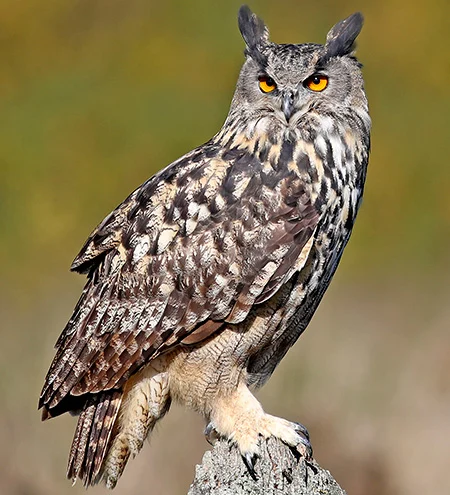
(Bubo bubo)
Eurasian Eagle-Owl
Пугач палеарктичний
It breeds in Europe and Northern Asia — north to forest edges, east to Yakutia, Sakhalin, and Japan, and south to North Africa, Arabia, and southern China. It mostly inhabits mountainous and rocky areas, often near varied woodland edge and near shrubby areas with openings or wetlands. Also occurs in coniferous forests, steppes, and remote areas.
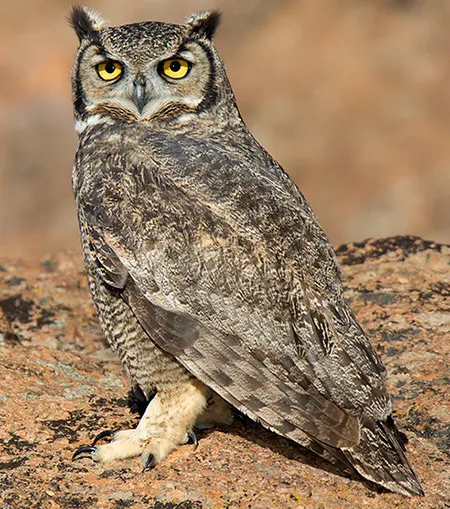
(Bubo magellanicus)
Lesser Horned Owl
Пугач магеланський
Its range extends from central Peru and western Bolivia southwards through Chile and western Argentina as far as Tierra del Fuego. The bird occurs in a variety of habitats including open forest, scrubland, farmland and grassland.
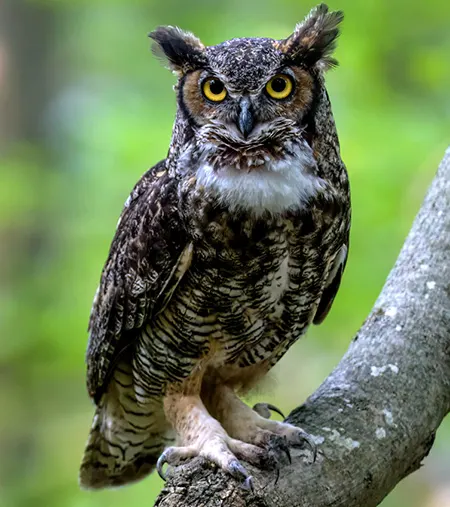
(Bubo virginianus)
Great Horned Owl
Пугач віргінський
It is distributed throughout most of North America and very spottily in Central America and then down into South America. It inhabits deciduous, coniferous, and mixed forests, tropical rainforests, pampas, prairie, mountainous areas, deserts, subarctic tundra, rocky coasts, mangrove swamp forests, and some urban areas.

(Bubo scandiacus)
Snowy Owl
Сова біла
It nests in the Arctic tundra of the northernmost stretches of Alaska, Northern Canada, and the Euro-Siberian region. In winter, it migrates to southern zones, including steppes and deserts.
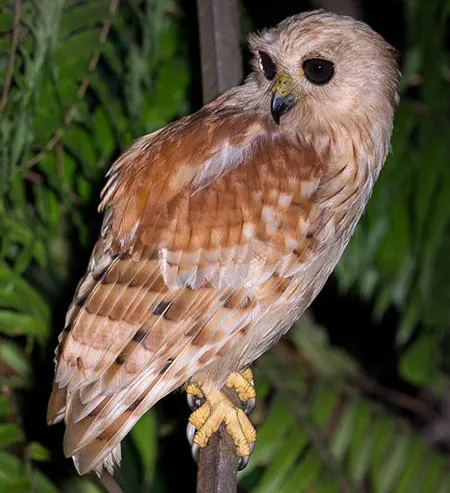
(Scotopelia ussheri)
Rufous Fishing Owl
Сова-рибоїд чорнодзьоба
It is endemic to west Africa. It is found in Ivory Coast, Ghana, Guinea, Liberia, and Sierra Leone, where it occurs as a highly localised resident along shady river banks. Its natural habitats are subtropical or tropical moist lowland forests and subtropical or tropical mangrove forests.
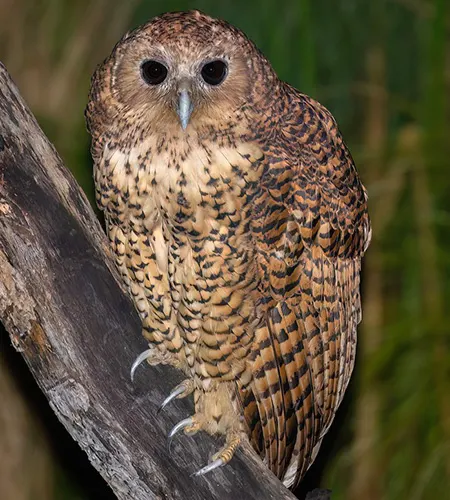
(Scotopelia peli)
Pel's Fishing Owl
Сова-рибоїд смугаста
It is patchily distributed in Nigeria, Senegal, the Gambia, Guinea, Sierra Leone, and in central Africa from the coast to eastern Zaire and discontinuously to South Sudan, Somalia, Kenya, and Tanzania and southwards to Zambia, Zimbabwe, Botswana, and eastern South Africa.
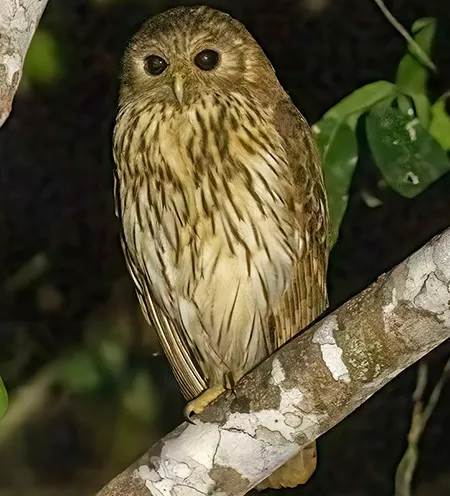
(Scotopelia bouvieri)
Vermiculated Fishing Owl
Сова-рибоїд жовтодзьоба
It is endemic to a large area of tropical west-central Africa extending from southern Nigeria in the west to South Sudan in the east and northern Angola to the south. It habitats gallery forests along rivers that are at least 10 m wide, and pools and flooded areas in forests; it sometimes occurs away from water.

(Ketupa philippensis)
Philippine Eagle-Owl
Пугач філіппінський
It is endemic to the Philippines, where it is found in lowland forests on the islands of Catanduanes, Samar, Bohol, Mindanao, Luzon, Leyte and possibly Sibuyan.
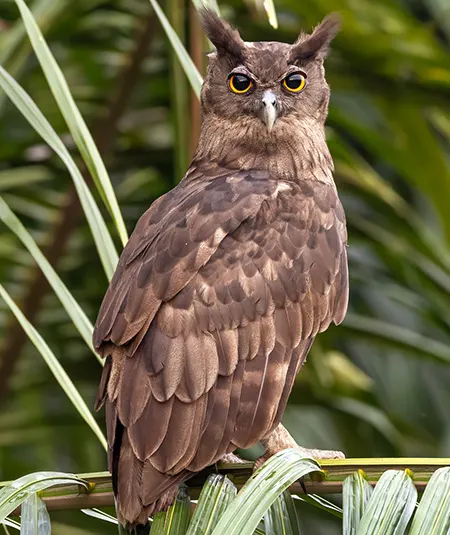
(Ketupa coromanda)
Dusky Eagle-Owl
Пугач брунатний
It is found from Pakistan, India, Nepal and Bangladesh to Myanmar, Thailand, Malaysia into China. It inhabits forests, wooded wetlands, agricultural areas with scattered groves and trees, and roadside avenues with old large trees.
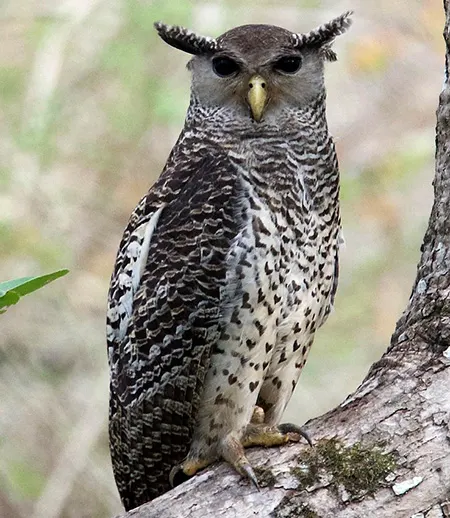
(Ketupa nipalensis)
Spot-Bellied Eagle-Owl
Пугач непальський
It is distributed through the Lower Himalayas from Kumaon east to Burma, and further to central Laos, central Vietnam, southern Thailand, and Sri Lanka. It inhabits primary and older secondary forests at elevations of 900–1,200 m.
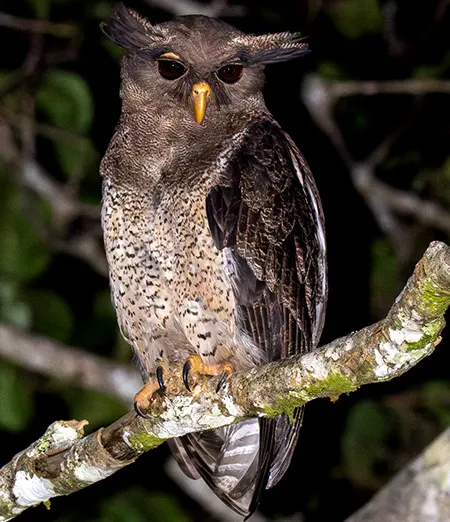
(Ketupa sumatrana)
Barred Eagle-Owl
Пугач суматранський
It is found in Brunei, Indonesia, Malaysia, Myanmar, Singapore, and Thailand. Its natural habitat is subtropical or tropical moist lowland forests. It typically is a resident of evergreen forests with pools or streams, but also ranges into large gardens with tall, densely foliated trees.

(Ketupa ketupu)
Buffy Fish Owl
Пугач-рибоїд малазійський
It is found from Bangladesh, Myanmar, Thailand, Malaysia and Singapore to Cambodia, Laos, Vietnam, and the Sunda Islands. It inhabits tropical forests and freshwater wetlands near rivers, lakes and aquaculture sites at elevations up to 1,600 m.

(Ketupa flavipes)
Tawny Fish Owl
Пугач-рибоїд рудий
It lives in subtropical to temperate forests in southern Nepal, northern India, Bangladesh, Bhutan, China, Laos, Myanmar, Taiwan, and Vietnam. It occurs at elevations of 1,500–2,450 m.
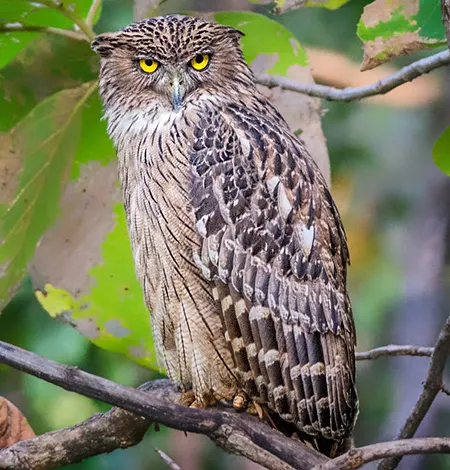
(Ketupa zeylonensis)
Brown Fish Owl
Пугач-рибоїд бурий
It is an all-year resident throughout most tropical and subtropical parts of the Indian Subcontinent to Southeast Asia and adjoining regions. It inhabits mainly the lowlands, from open woodland to dense forest as well as in plantations; in the Himalayas foothills it ranges into submontane forest up to 1,500 m.

(Ketupa blakistoni)
Blakiston's Fish Owl
Пугач далекосхідний
It is found in eastern Russia from Magadan to Primorye, Sakhalin and the southern Kuril Islands, as well as in Japan and north-eastern China. It occurs in dense, minimally or undisturbed old-growth forest near waterways including floodplains or wooded coastlines.
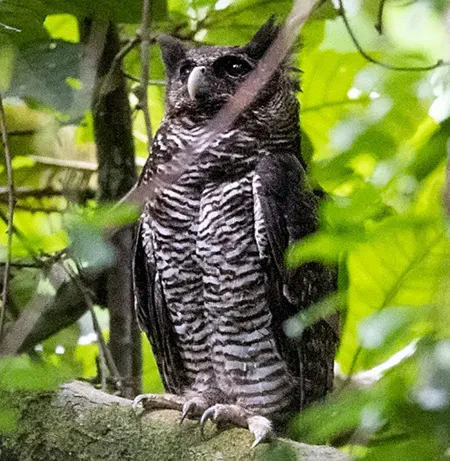
(Ketupa shelleyi)
Shelley's Eagle-Owl
Пугач камерунський
It is found in Central and Western Africa. It has been found in widely scattered locations, perhaps isolated by habitat destruction. It is a resident of lowland tropical rainforests and has never been recorded outside densely forested or old-growth areas.
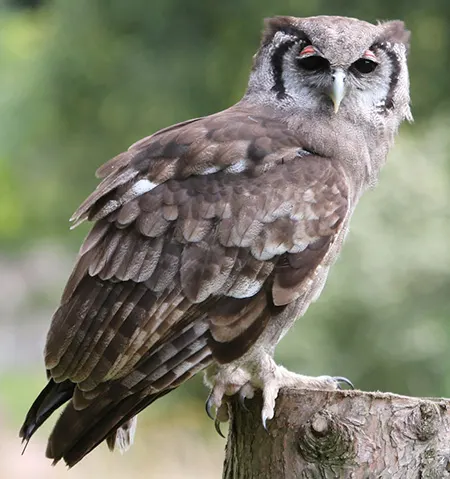
(Ketupa lactea)
Verreaux's Eagle-Owl
Пугач блідий
It is found through most of sub-Saharan Africa, though it is absent from most of the deep rainforests. It is found at the highest densities in eastern and southern Africa. Because it avoids primary forests, it is found very spottily in west Africa.
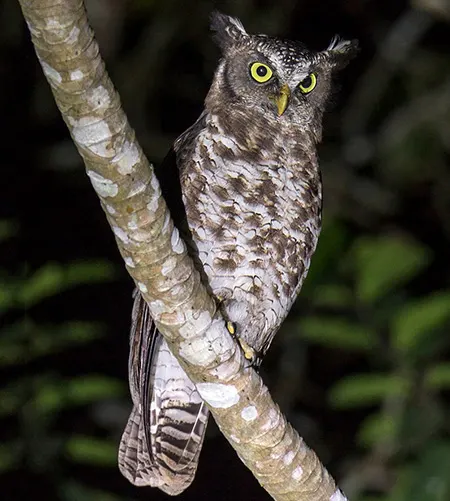
(Ketupa leucosticta)
Akun Eagle-Owl
Пугач плямистогрудий
It has a patchy range that extends through a number of the west African countries which have coastlines on the Gulf of Guinea, from Guinea east to Cameroon and south to Angola, extending inland into the southern Central African Republic, Congo and northern parts of the Democratic Republic of Congo.
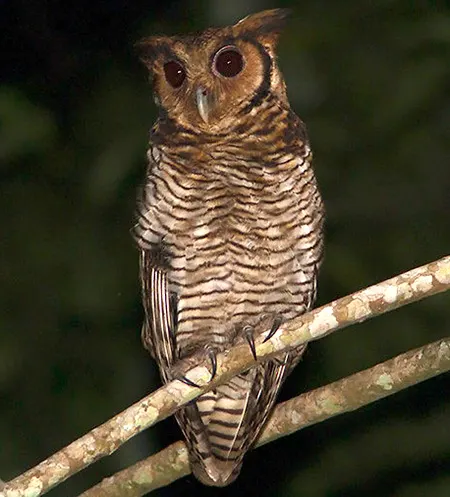
(Ketupa poensis)
Fraser's Eagle-Owl
Пугач гвінейський
It is widely distributed across the African tropical rainforest and is also found on Bioko. It inhabits primarily forests, forest clearings, and cardamom plantations at elevations up to 1,600 m.
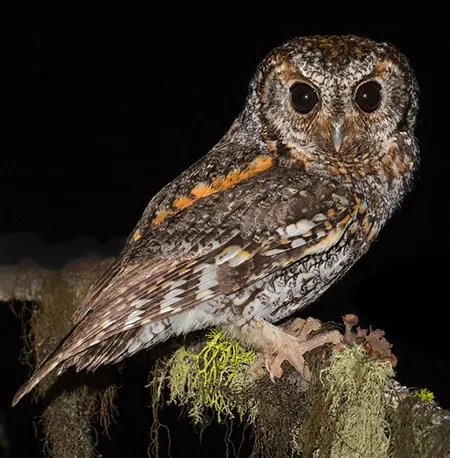
(Psiloscops flammeolus)
Flammulated Owl
Сплюшка канадська
It breeds from southern British Columbia and the western United States to central Mexico. As a Neotropical migrant, it winters from southern Mexico to Guatemala and El Salvador. It typically inhabits coniferous forests.

(Gymnasio nudipes)
Puerto Rican Owl
Сплюшка пуерто-риканська
It is endemic to the archipelago of Puerto Rico. It inhabits moist lowland forests, but it is also found in dry forests and urban areas.
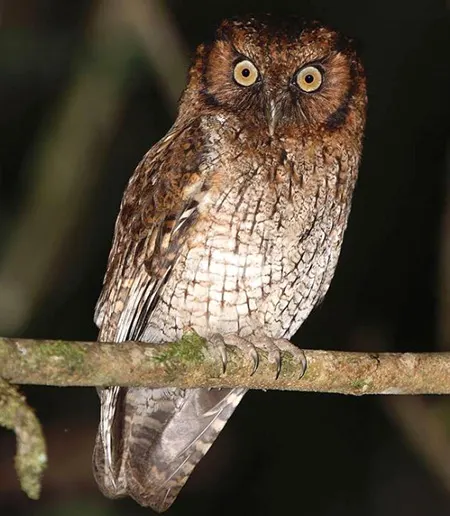
(Megascops atricapilla)
Black-capped Screech-Owl
Сплюшка темноголова
It is found in south-eastern Brazil, south-eastern Paraguay, and extreme north-eastern Argentina. It inhabits a variety of landscapes, especially lowland rainforest and including forest with thick undergrowth, edges, open woodland, and secondary forest.
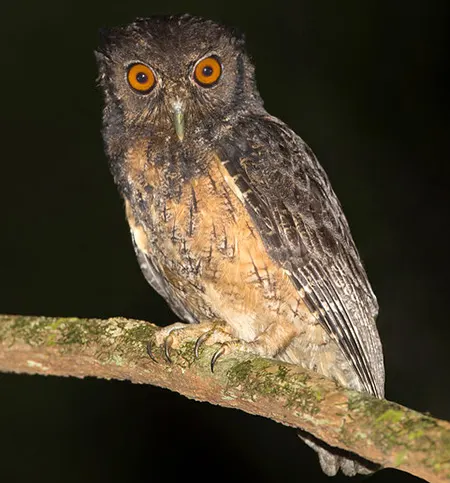
(Megascops watsonii)
Tawny-bellied Screech-Owl
Сплюшка амазонійська
It is found in Bolivia, Brazil, Colombia, Ecuador, French Guiana, Guyana, Peru, Suriname, and Venezuela. It inhabits the interior of lowland rainforest, mostly old growth and mature secondary forest, at elevations of 600–700 m.
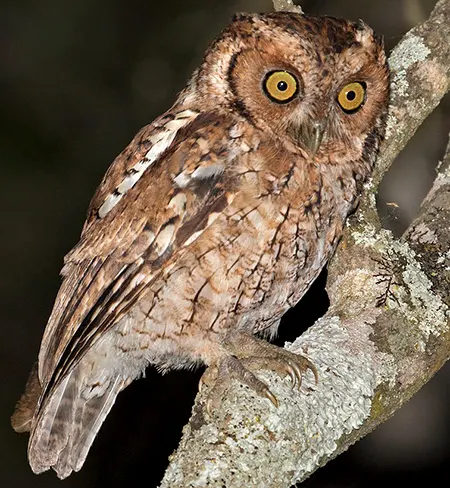
(Megascops roboratus)
West Peruvian Screech-Owl
Сплюшка чагарникова
It is found from Santa Elena and Guayas Provinces in south-western Ecuador south slightly into north-western Peru. It inhabits dry deciduous woodland on mountain slopes and hills, dry coastal scrub and deciduous forests at elevations of 500–2,100 m.
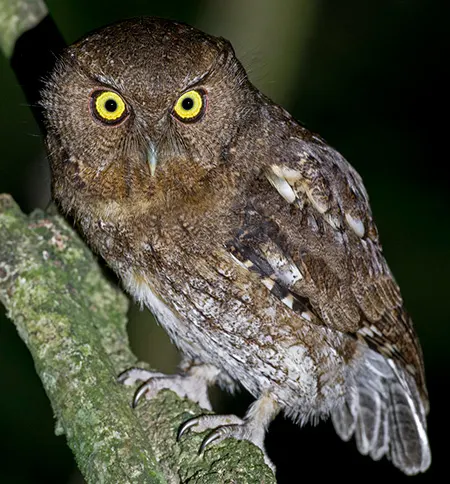
(Megascops gilesi)
Santa Marta Screech-Owl
Сплюшка санта-мартійська
It is known only from Sierra Nevada de Santa Marta of northern Colombia. It inhabits humid forests at elevations of 1,800–2,500 m.
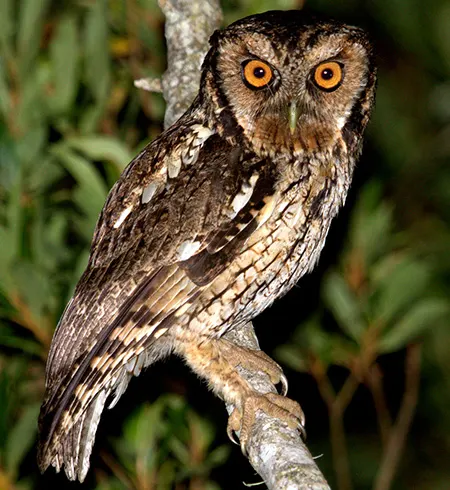
(Megascops sanctaecatarinae)
Long-tufted Screech-Owl
Сплюшка санта-катаринська
It is found in the southeastern Brazilian states of Paraná, Santa Catarina, and Rio Grande do Sul, in Misiones Province of northeastern Argentina, and in adjoining northern Uruguay. It inhabits sparse woodland, pastures with trees, the edges of dense forest, secondary forest, and woodlots near villages.
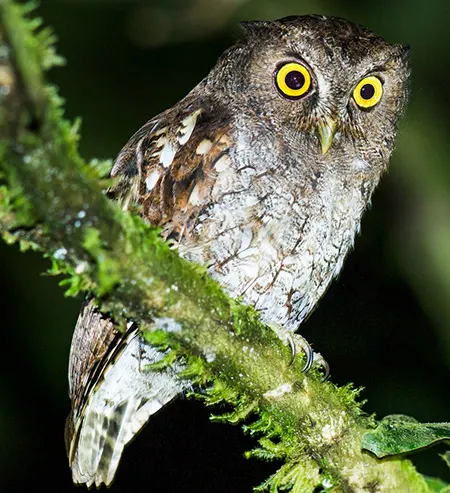
(Megascops roraimae)
Foothill Screech-Owl
Сплюшка нагірна
It is found in southern and northern Venezuela, southern Guyana, Suriname, eastern Colombia, eastern Peru, northern Bolivia, and eastern Ecuador. It inhabits dense humid to wet rainforest at elevations of 250–1,800 m.
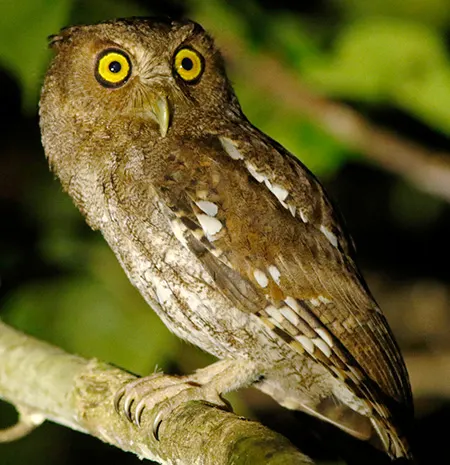
(Megascops centralis)
Chocó Screech-Owl
Сплюшка чокоанська
It is found from central Panama into north-western Colombia and in a narrow band of western Ecuador. It inhabits the interior and borders of humid primary and secondary forest in lowlands and foothills at elevations of 1,000–1,575 m.
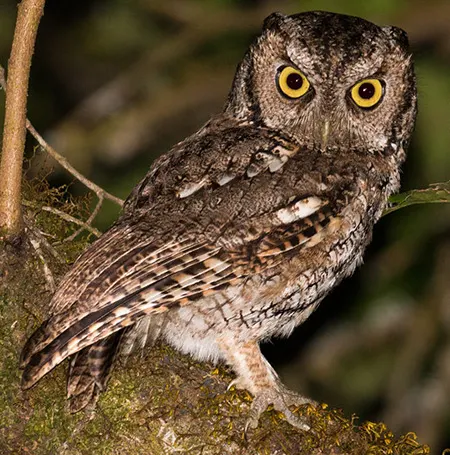
(Megascops hoyi)
Montane Forest Screech-Owl
Сплюшка аргентинська
It is found from south-central Bolivia’s Cochabamba Department south into north-western Argentina as far as Tucumán Province. It inhabits moist montane and cloud forests characterized by tall trees and abundant epiphytes at elevations of 1,000–2,800 m.
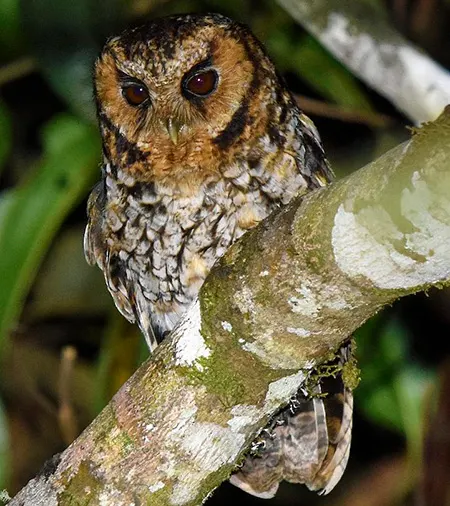
(Megascops marshalli)
Cloud-forest Screech-Owl
Сплюшка Маршалла
It lives in the Andes of south and central Peru, in the Departments of Pasco, Cuzco, and Puno, as well as in northern Bolivia. It inhabits cloud forest, a humid, mossy landscape with epiphytes, ferns, and a dense understory, at elevations of 1,550–2,580 m.

(Megascops petersoni)
Cinnamon Screech-Owl
Сплюшка еквадорська
It is known only from the eastern slope of the Andes, ranging from southern Ecuador into northern Peru, and occurring locally in northern Colombia. It inhabits humid montane forest at elevations of 1,650–2,450 m.
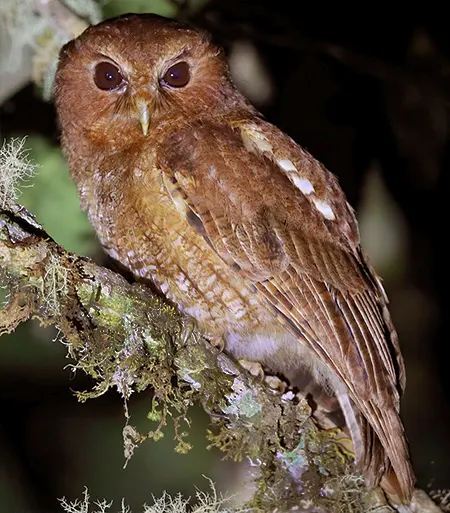
(Megascops ingens)
Rufescent Screech-Owl
Сплюшка андійська
It is found in Bolivia, Colombia, Ecuador, Peru, and Venezuela. It inhabits a wide variety of forest types including the interior and edges of mature evergreen and secondary forests and pastures with scattered trees, at elevations of 1,200–2,500 m.
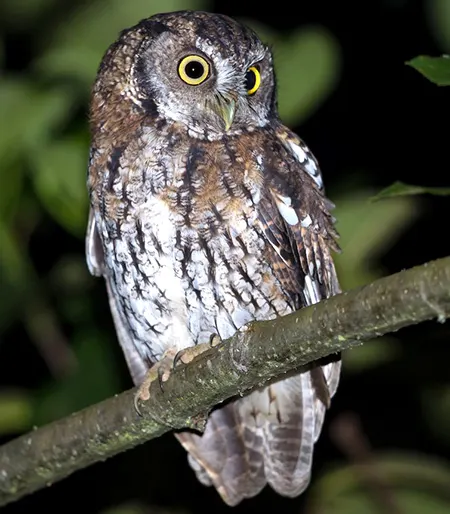
(Megascops koepckeae)
Koepcke's Screech-Owl
Сплюшка високогірна
It is endemic to Peru. It inhabits evergreen forests, dry forests, and scrubby areas in intermontane valleys. It occurs at elevations of 1,400–4,500 m.
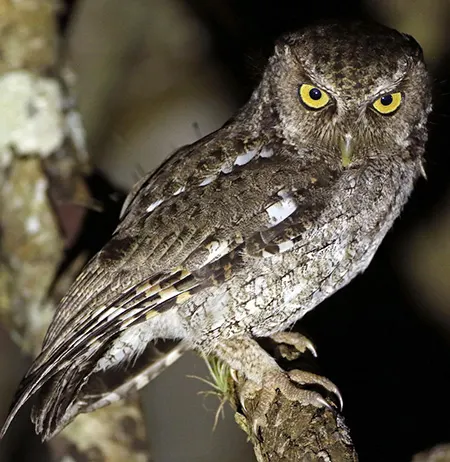
(Megascops guatemalae)
Guatemalan Screech-Owl
Сплюшка гватемальська
It is found from northern Mexico to western Panama. It inhabits evergreen, semi-deciduous, and thorn forests, and to a lesser extent, secondary forests and plantations at elevations of 0–1,500 m.
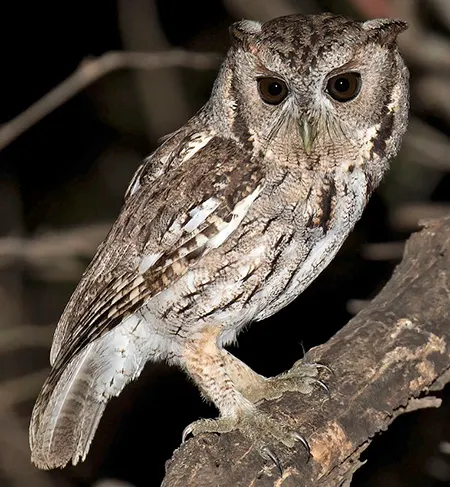
(Megascops seductus)
Balsas Screech-Owl
Сплюшка бура
It is endemic to interior southwestern Mexico. Its range is centered on the valley of the Balsas River from southern Jalisco southeast into central Guerrero. It inhabits arid open and semi-open areas such as deciduous woodland with cactus, thorn forest, and secondary forest, at elevations of 600–1,500 m.

(Megascops asio)
Eastern Screech-Owl
Сплюшка східна
It is found in eastern North America, ranging from Mexico northward to Canada. It inhabits most types of woodland habitats across its range, and is relatively adaptable to urban and developed areas.
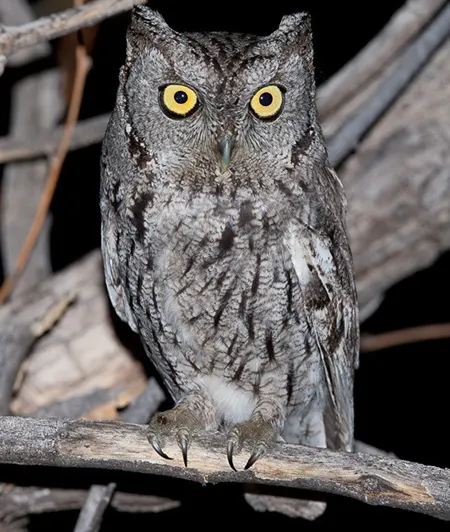
(Megascops kennicottii)
Western Screech-Owl
Сплюшка західна
It is native to Canada, United States, Mexico, Guatemala, El Salvador, Honduras, Costa Rica, and Nicaragua. Its habitat includes temperate forests, subtropical and tropical montane forests, shrubland, desert, rural fields, and even suburban parks and gardens.
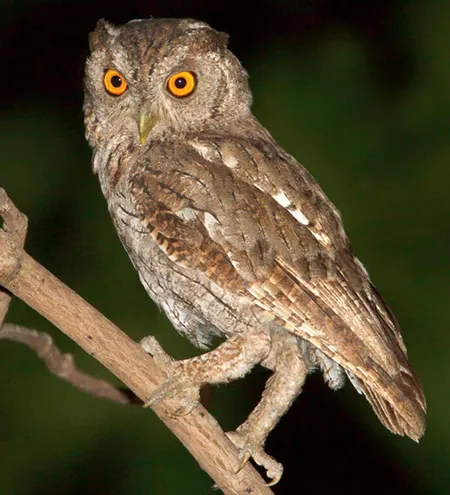
(Megascops cooperi)
Pacific Screech-Owl
Сплюшка мангрова
It is found from eastern Oaxaca and Chiapas in Mexico, south along the Pacific slope into north-western Costa Rica. It inhabits swamp forests and mangroves, arid and semi-arid woodlands and scrub, open areas with scattered trees and cacti, and secondary forest.
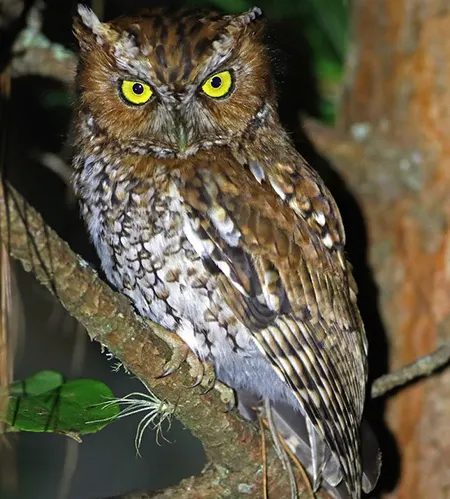
(Megascops barbarus)
Bearded Screech-Owl
Сплюшка чіапська
It is found from the highlands of central Chiapas, Mexico south and east into the highlands of central and western Guatemala. It inhabits humid temperate montane forests of various types, including pine-oak, oak, and cloud forests, at elevations of 1,350–2,500 m.
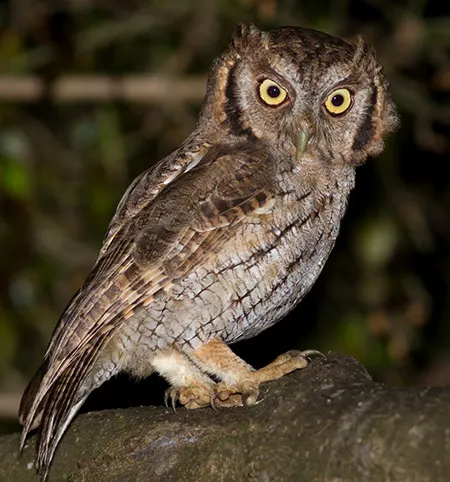
(Megascops choliba)
Tropical Screech-Owl
Сплюшка неотропічна
It is found from Costa Rica and Panama south and throughout South America, almost entirely east of the Andes, but not in the far south. It inhabits secondary forests, open woodland, coffee plantations, residential areas, and the borders of terra firme and várzea forests.

(Megascops albogularis)
White-throated Screech-Owl
Сплюшка білогорла
It is found in the Andes of Bolivia, Colombia, Ecuador, Peru and Venezuela. It inhabits the interior and edges of open humid evergreen montane forest and cloud forest and semi-open areas of scattered trees, at elevations of 1,300–3,700 m.

(Megascops clarkii)
Bare-shanked Screech-Owl
Сплюшка коста-риканська
It is found in Costa Rica, Panama, and far north-western Colombia. Its habitat is in mountain forests that are dense and humid, along with the edges of forests and in cloud forests that have an elevation of 900–3,300 m.
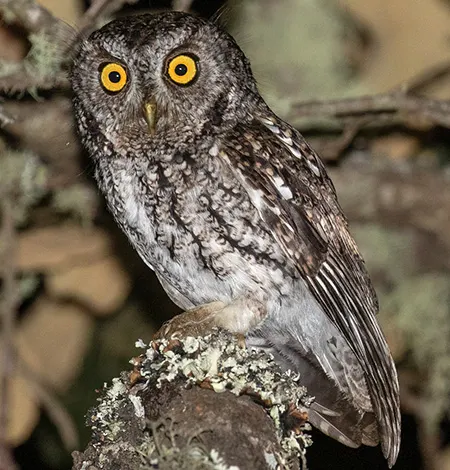
(Megascops trichopsis)
Whiskered Screech-Owl
Сплюшка вусата
It is found from south-eastern Arizona and south-western New Mexico in the United States, south through Mexico, Guatemala, El Salvador, and Honduras to north-central Nicaragua. Its breeding habitat includes dense coniferous or oak woodlands and coffee plantations.
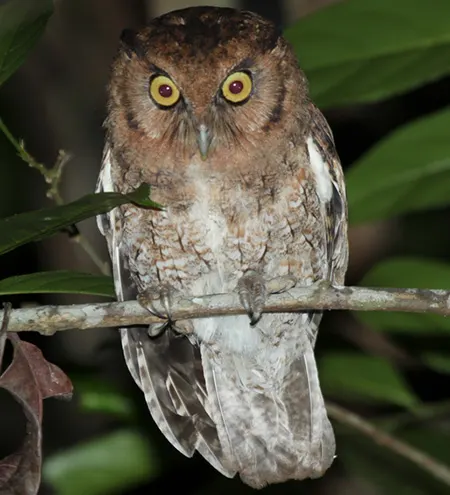
(Megascops alagoensis)
Alagoas Screech-Owl
Сплюшка алагоаська
It is found only in the Atlantic Forest north of the São Francisco River of Brazil, and is threatened by forest fragmentation.
The genus (Megascops) also includes: Xingu Screech-Owl (Megascops stangiae).
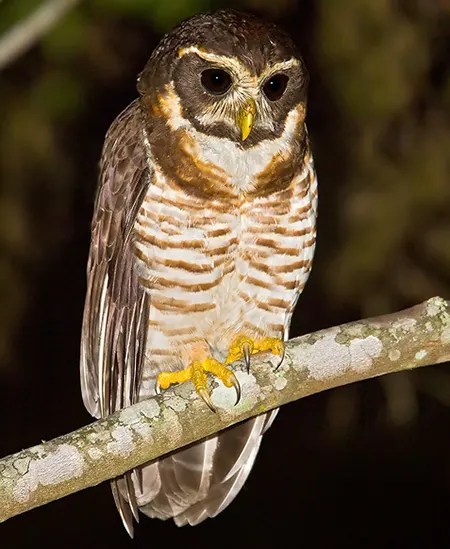
(Pulsatrix melanota)
Band-bellied Owl
Сова рудовола
It is found on the eastern slopes of the Andes, from central Colombia south through Ecuador and Peru to west-central Bolivia. It primarily inhabits the interior of humid montane forests and foothill rainforests, at elevations of 650–2,200 m.
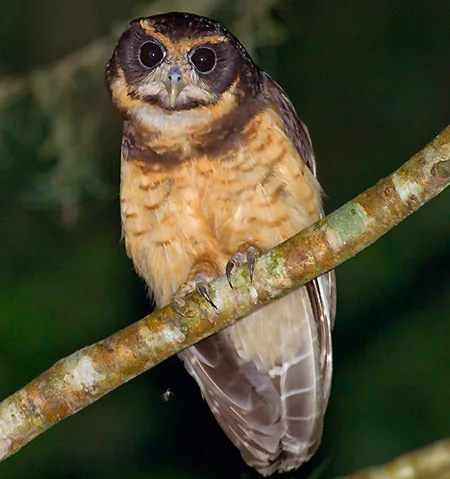
(Pulsatrix koeniswaldiana)
Tawny-browed Owl
Сова вохристоброва
It is found in Brazil from Espírito Santo state south to northern Rio Grande do Sul and the immediately adjacent areas of eastern Paraguay and northeastern Argentina. It inhabits humid tropical forest, open woodland, and forest dominated by Araucaria evergreens, at elevations up to 1,500 m.

(Pulsatrix perspicillata)
Spectacled Owl
Сова вохристочерева
It is found in forests from southern Mexico and Trinidad, through Central America, and south to southern Brazil, Paraguay, and northwestern Argentina.
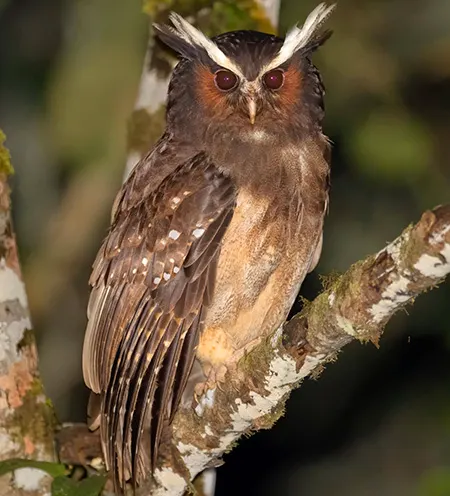
(Lophostrix cristata)
Crested Owl
Сова-рогань бура
It is found in Central America and northern South America. It occurs throughout most of the Amazon Basin, except in the northwestern region. Its natural habitats are subtropical or tropical moist lowland forests and subtropical or tropical moist montane forests, at elevations up to 1,000 m.

(Strix seloputo)
Spotted Wood Owl
Сова таїландська
It is found in Myanmar, Thailand, Cambodia, southern Vietnam, Peninsular Malaysia, Singapore, Indonesia (Sumatra, Java, and Bawean), and the western Philippines (Palawan and the Calamian Islands). It inhabits plantations, forest clearings, evergreen secondary forests, and forest edges.
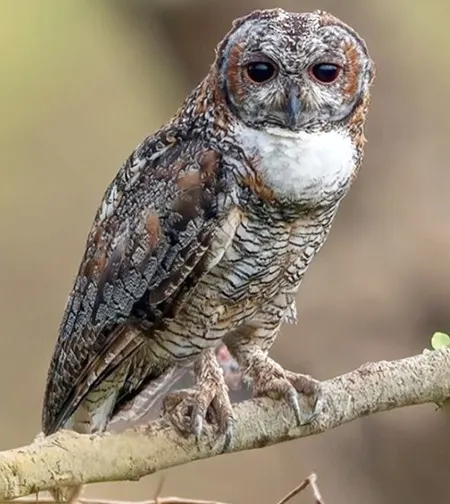
(Strix ocellata)
Mottled Wood Owl
Сова мангрова
It is fairly common throughout the Indian subcontinent and in the Himalayan foothills of India and southern Nepal. It is found in the plains in gardens and lightly wooded habitats.
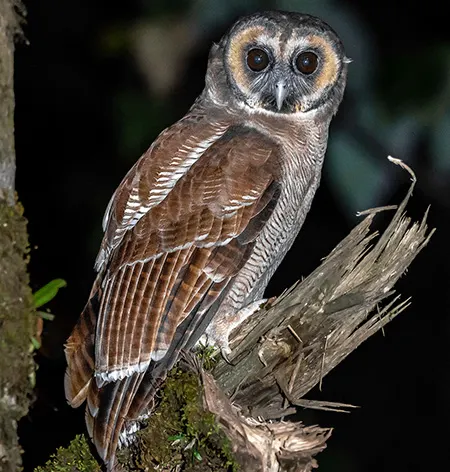
(Strix leptogrammica)
Brown Wood Owl
Сова бура
It lives in coastal woodlands and tropical forests, ranging from India and Sri Lanka to south-western China, and from Myanmar south to Malaysia, Sumatra, and Borneo. It occurs at elevations of 700–4,000 m.
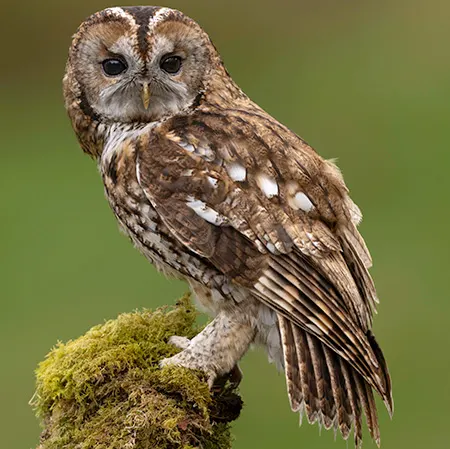
(Strix aluco)
Tawny Owl
Сова сіра
It has a distribution stretching discontinuously across temperate Europe, from Great Britain and the Iberian Peninsula eastwards to western Siberia. It is found in deciduous and mixed forests, and sometimes mature conifer plantations, at elevations of 0–2,400 m.
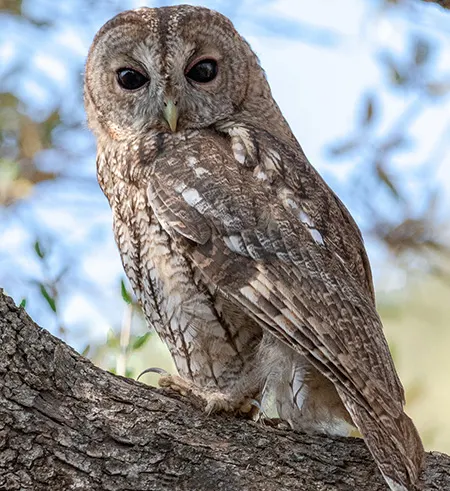
(Strix mauritanica)
Maghreb Owl
Сова мавританська
It occurs in north-western Africa from Morocco to Tunisia and Mauritania.
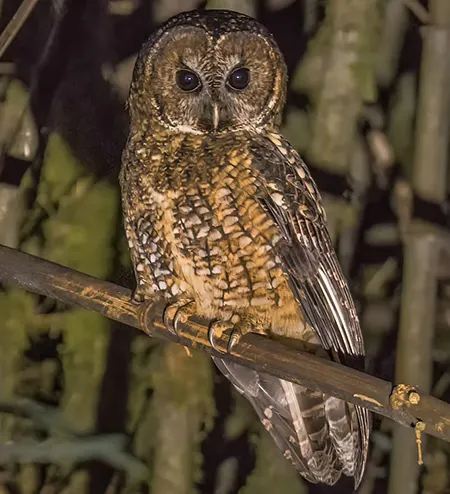
(Strix nivicolum)
Himalayan Owl
Сова гімалайська
The range extends from the Indian state of Himachal Pradesh, Nepal, and south-eastern Tibet eastward to the east coast of China, Taiwan, and Korea, and southward to southern Assam, north-western Myanmar, and northern Vietnam. It occurs at elevations of 1,000–2,700 m.
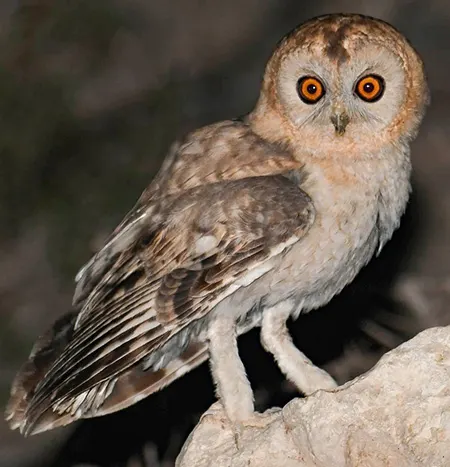
(Strix hadorami)
Desert Owl
Сова бліда
It breeds in Israel, northeast Egypt, Jordan, and the Arabian Peninsula. Its habitat includes desert, semi-desert, rocky ravines, and palm groves. It nests in crevices and holes in cliffs.
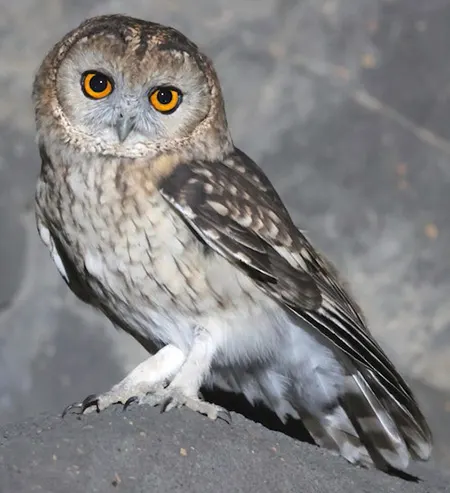
(Strix butleri)
Omani Owl
Сова аравійська
It is found in shrubland and rocky areas of Oman, Iran and the United Arab Emirates.
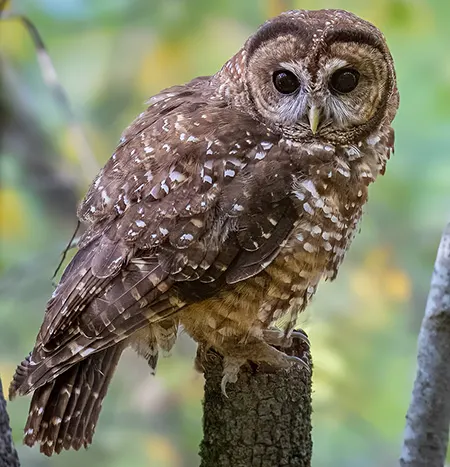
(Strix occidentalis)
Spotted Owl
Сова плямиста
It is found in western North America, ranging from British Columbia to Mexico. It occurs in a variety of hardwood and coniferous forest habitats, although it prefers closed-canopy, uneven-aged, late-successional, and old-growth forests.
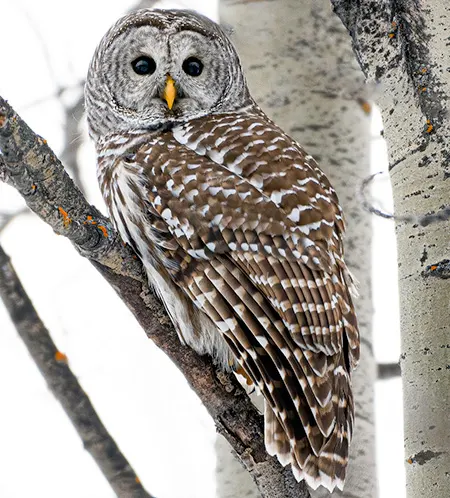
(Strix varia)
Barred Owl
Сова неоарктична
It is distributed throughout most of the eastern United States, as well as much of southern Canada. Its habitat consists mainly of old deciduous and mixed forests, and occasionally coniferous
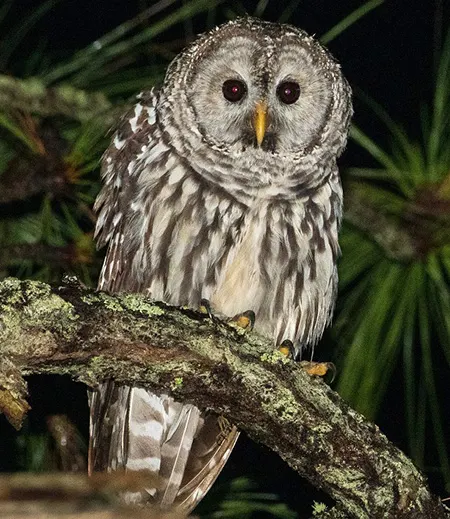
(Strix sartorii)
Cinereous Owl
Сова мексиканська
It occurs in three disjunct areas. The largest is along the Sierra Madre Oriental between San Luis Potosi in the north and Veracruz in the south. The next largest is a band from Durango south to Michoacán and the third is a relatively small area in Guerrero.

(Strix fulvescens)
Fulvous Owl
Сова чіяпська
It is found in highland regions in the Mexican states of Chiapas and Oaxaca, Guatemala, Honduras, and El Salvador. It imnhabits in montane evergreen pine forests and humid pine-oak forests, and more generally within a cloud forest habitat.
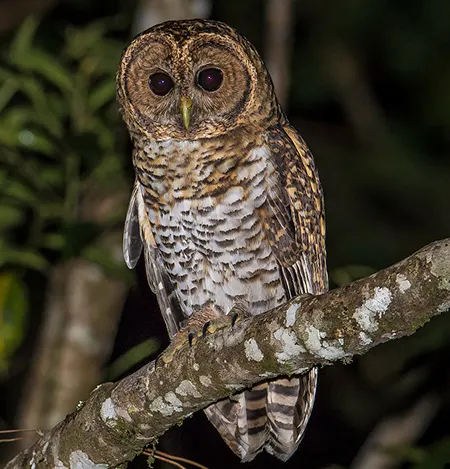
(Strix hylophila)
Rusty-barred Owl
Сова бразильська
It is found in south-eastern Brazil from Minas Gerais to Rio Grande do Sul, in south-eastern Paraguay, and in Argentina’s extreme north-eastern Misiones Province. It inhabits the interior and edges of a variety of wooded landscapes including montane, tropical evergreen, and temperate forest, at elevations up to 1,000 m.

(Strix chacoensis)
Chaco Owl
Сова болівійська
It is found in southern South America, from Bolivia’s Santa Cruz Department south through western Paraguay into north-central Argentina. It inhabits the Gran Chaco at elevations of 500–1,300 m.
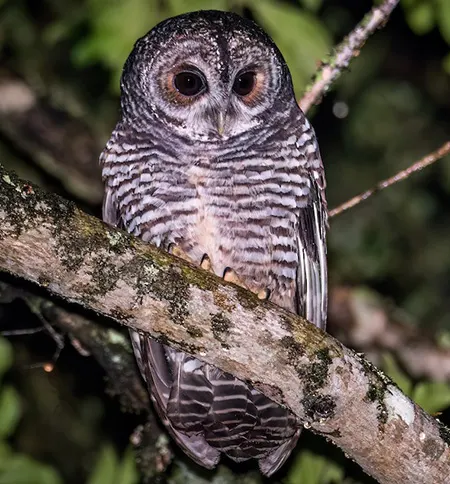
(Strix rufipes)
Rufous-legged Owl
Сова патагонська
It is found in Chile from Valparaíso Province and in far western Argentina from Mendoza Province south to the tip of Tierra del Fuego. It primarily inhabits moist old-growth forests with a closed canopy and dense understory, at elevations up to 2,000 m.

(Strix uralensis)
Ural Owl
Сова довгохвоста
The breeding range extends as far west as much of Scandinavia, montane eastern Europe, and, sporadically, central Europe, thence sweeping across the Palearctic broadly through Russia to as far east as Sakhalin and throughout Japan.

(Strix nebulosa)
Great Grey Owl
Сова бородата
It breeds in North America, from as far east as Quebec to the Pacific coast and Alaska. In Eurasia, its breeding range extends north to 52°N latitude, from Scandinavia east to the Anadyr Basin and along the coasts of the Sea of Okhotsk and the Sea of Japan.
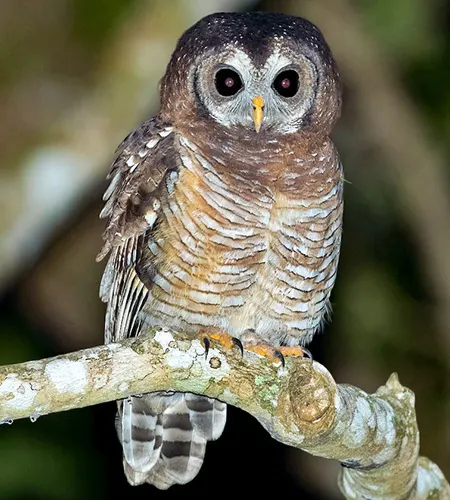
(Strix woodfordii)
African Wood Owl
Сова-лісовик африканська
It is found throughout much of sub-Saharan Africa. Its range extends from Senegal and The Gambia eastward to Ethiopia, and south to Angola, Botswana, and Zimbabwe. It is also inhabits in Mozambique and the Cape Province of South Africa.
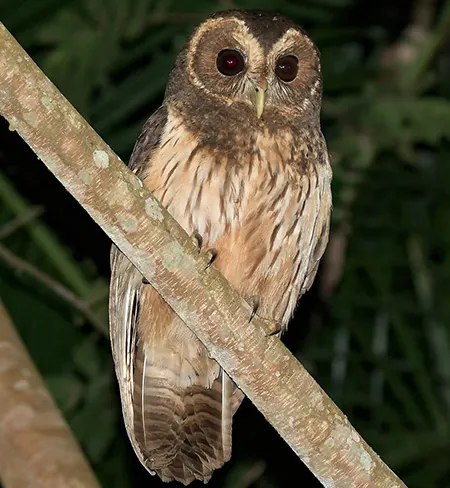
(Strix virgata)
Mottled Owl
Сова-лісовик бура
It is native to Central and South America. Its range extends from Mexico south to Argentina and Brazil, occurring at elevations up to 2,500 m. It inhabits a variety of wooded habitats and plantations, as well as open countryside with scattered trees.
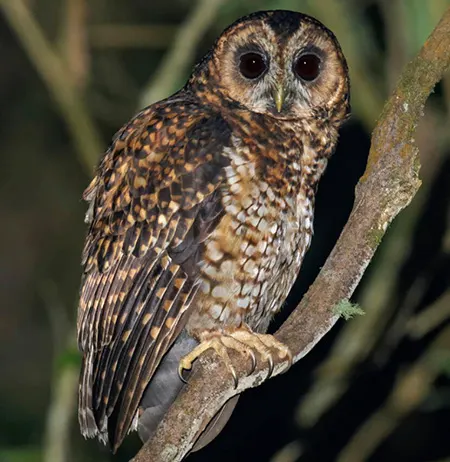
(Strix albitarsis)
Rufous-banded Owl
Сова-лісовик руда
It is found in the Andes, from northern Venezuela south to western and southern Bolivia. It inhabits humid evergreen montane forest and cloud forests with a dense understory, epiphytes, and mosses, at elevations of 1,700–3,700 m.
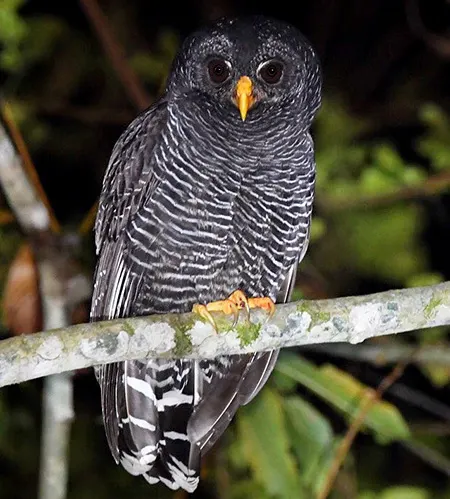
(Strix huhula)
Black-banded Owl
Сова-лісовик смугаста
Its natural habitats are varied subtropical or tropical forests ranging from lowlands to areas of medium altitude, and it has been found in Argentina, Bolivia, Brazil, Colombia, Ecuador, French Guiana, Guyana, Paraguay, Peru, Suriname, and Venezuela.
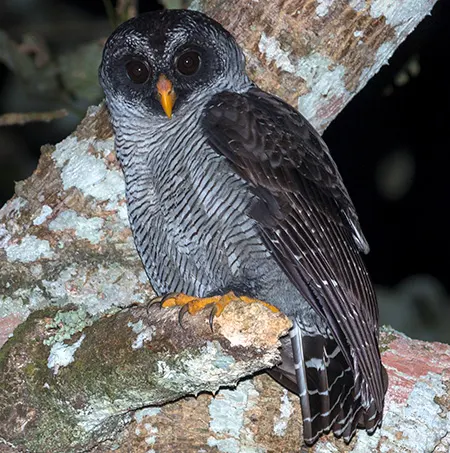
(Strix nigrolineata)
Black-and-white Owl
Сова-лісовик строката
Its range extends from central Mexico south to the north-western section of Peru and western Colombia. It is mostly found in gallery forests and rainforests, but also occurs in wet deciduous and mangrove forests at elevations of 0–2400 m.

